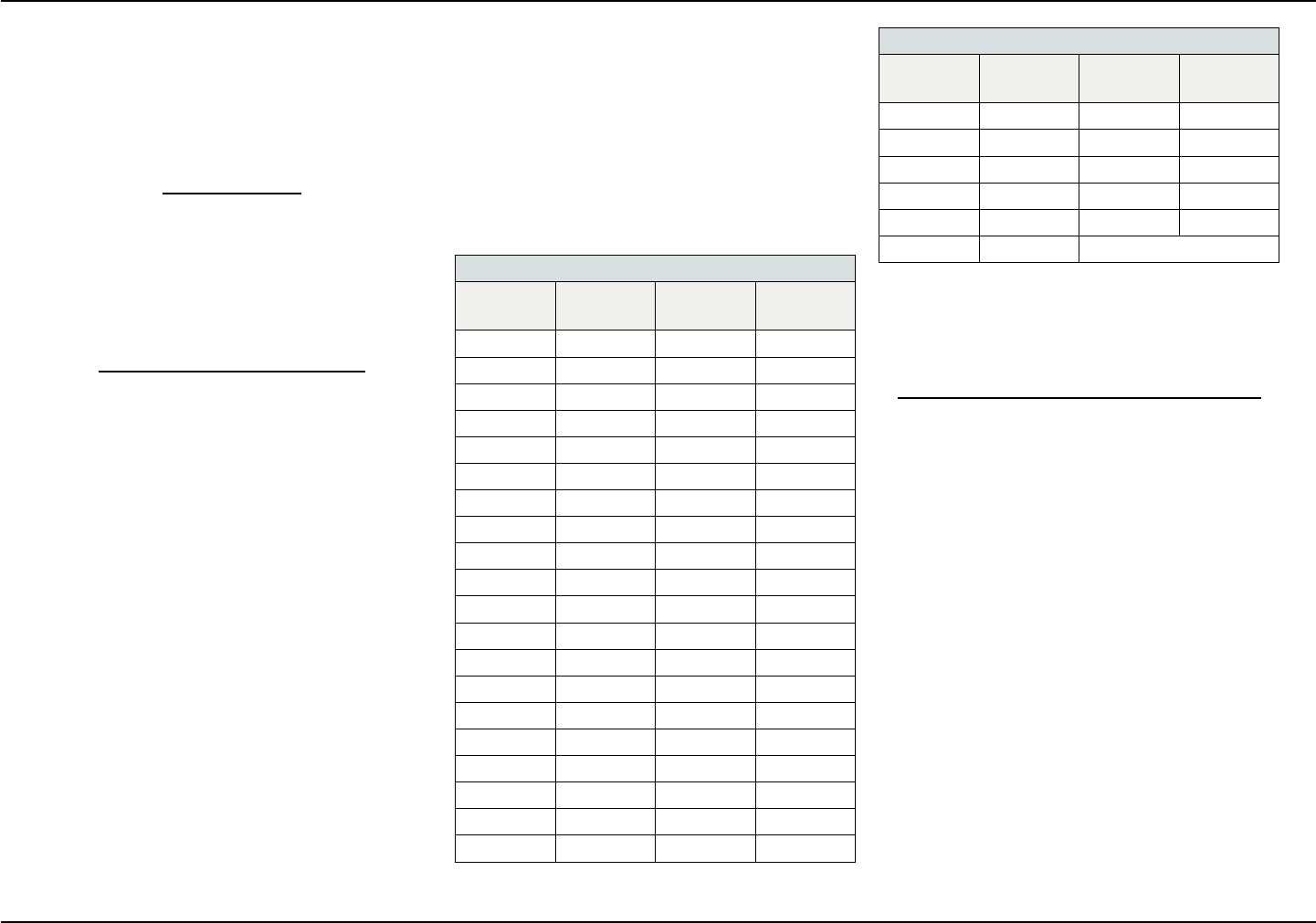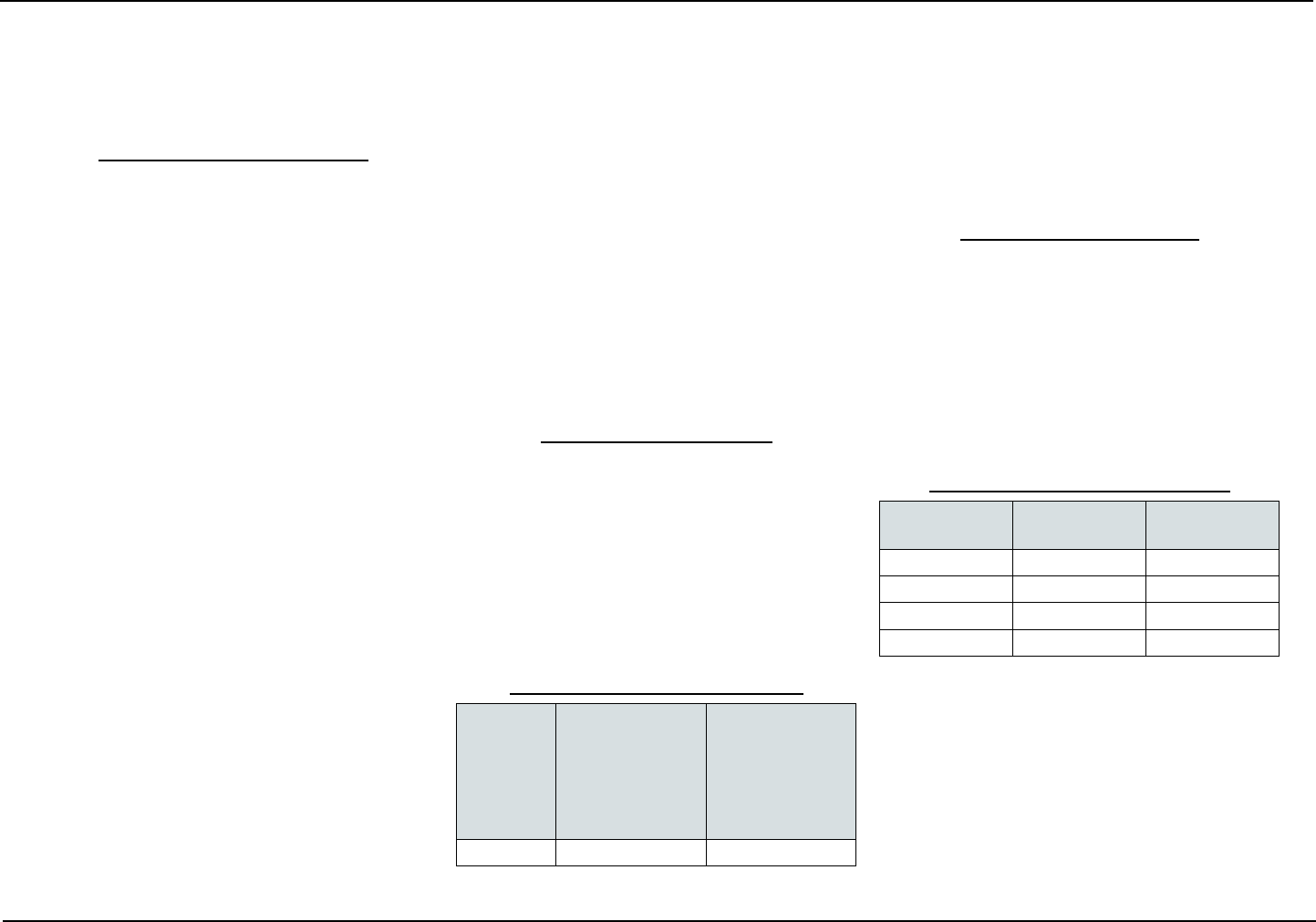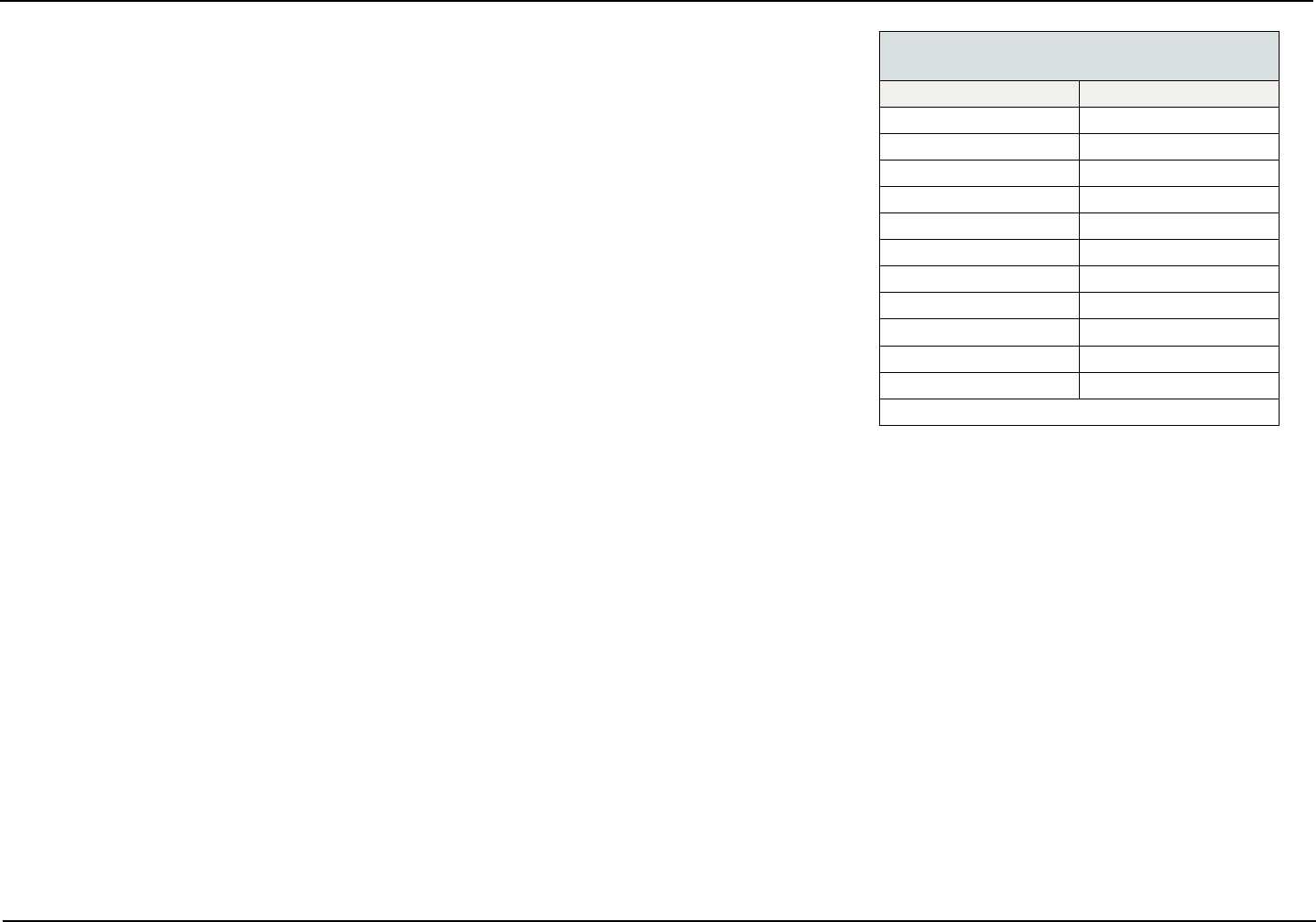
Public Employees’
Retirement System(PERS)
Member Guidebook
Pensions & Benefits
SP-0333-0624

PERS Member Guidebook June 2024 Page 2
Public Employees’ Retirement System
TABLE OF CONTENTS
PERS General Information ...................3
Foreword ..............................4
The Retirement System ....................4
Contacting the New Jersey Division of
...............4
Plan Information ..........................5
Eligibility ..................................6
Membership .............................7
Part-time Crossing Guards. . . . . . . . . . . . . . . . . . 8
...............8
Enrollments ...............................9
Overview ..............................10
Multiple and Dual Membership. . . . . . . . . . . . . . 11
Transfers ..............................12
Service Credit. . . . . . . . . . . . . . . . . . . . . . . . . . . 13
Vesting ................................13
Purchasing Service Credit ..................14
Overview ..............................15
Types of Service Eligible for Purchase. . . . . . . . 15
Important Purchase Notes .................16
Cost and Procedures for
Purchasing Service Credit .................16
Applying to Purchase Service Credit .........17
Loans ...................................19
Overview ..............................20
Applying for a Loan ......................21
Internal Revenue Service (IRS)
Requirements ...........................21
Supplementing your Pension ................23
Overview ..............................24
Retirements ..............................25
Overview ..............................26
Types of Retirement ......................26
Optional Settlements at Retirement ..........30
The Retirement Process ..................31
.....35
Employment After Retirement ..............36
Active and Retired Death Benets ............37
Overview ..............................38
...................39
Payment of Group Life Insurance ...........39
Group Life Insurance and
Leave of Absence. . . . . . . . . . . . . . . . . . . . . . . . 39
Taxation of Group Life
Insurance Premiums .....................40
Waiving Noncontributory Group
Life Insurance over $50,000. . . . . . . . . . . . . . . . 40
Conversion of Group Life Insurance .........41
..................41
Withdrawal ...............................43
Overview ..............................44
Withdrawing Contributions .................45
Workers’ Compensation ...................45
Appeals. . . . . . . . . . . . . . . . . . . . . . . . . . . . . . . . . . 47
Overview ..............................48

PERS General
Information

PERS Member Guidebook June 2024 Page 4
Public Employees’ Retirement System
FOREWORD
The New Jersey Public Employees’ Retirement Sys-
tem (PERS) Member Guidebook provides a summa-
the rules and regulations governing the plan. The
PERS Member Guidebook should provide you with all
the plan or regulations implementing the statutes, the
statutes and regulations will take precedence. Com-
are set forth in the New Jersey Statutes Annotated.
Regulations, new or amended, are published in the
-
trative Law supplementing the New Jersey Admin-
istrative Code. This guidebook, containing current
updates, is available for viewing on our website at:
www.nj.gov/treasury/pensions While at the New Jer-
be sure to check for PERS-related forms, fact sheets,
Addenda guidebooks have been created for the Law
Prosecutors Part, and Workers’ Compensation Judges
Part, which are components of the PERS, but have sig-
for viewing on our website.
The purpose of this guidebook is to provide you with
information about the retirement system to assist you
in making decisions concerning you and your family’s
future. If you have questions concerning your retire-
(NJDPB)” section.
Since this is your guidebook, we would appreciate any
comments or suggestions for improvement that you
might have. Please send them to the address listed be-
low.
New Jersey Division of Pensions & Benets
ATTN: Oce of Communications
P.O. Box 295
Trenton, NJ 08625-0295
THE RETIREMENT SYSTEM
The State of New Jersey established the PERS in 1955
to replace the former State Employees’ Retirement
System. The NJDPB is assigned all administrative
functions of the retirement system except for invest-
ment.
The PERS Board of Trustees has the responsibility
for the proper operation of the retirement system. The
Board consists of:
• Six employee representatives;
• The State Treasurer; and
• Two individuals appointed by the Governor.
The Board meets once per month. A PERS member
who wishes to be a candidate upon a vacancy for the
PERS Board of Trustees must be nominated by peti-
tions bearing the signatures of 500 active members.
Nominating petition forms, along with instructions
of the PERS Board of Trustees, P.O. Box 295, Trenton,
NJ 08625-0295.
CONTACTING THE NEW JERSEY
DIVISION OF PENSIONS & BENEFITS (NJDPB)
Member Benets Online System
registered PERS members access to their pension
online. Resources available through MBOS include:
pension loan; purchase of service credit; withdrawal
application; and retirement applications. If applicable,
account information for the New Jersey State Employ-
ees’ Deferred Compensation Plan (NJSEDCP), Sup-
plemental Annuity Collective Trust (SACT), and State
Retirees may use MBOS to: view retirement account
information; update an address; change direct deposit
-
date federal and/or New Jersey State income tax with-
holding.
Before you can begin using MBOS, you must be reg-
istered with MBOS and the MyNewJersey website.
Registration information can be found on the NJDPB
website.
If you need assistance registering for MBOS, call
the MBOS Help Line at (609) 292-7524 or send
pensions.nj@treas.nj.gov
Telephone Numbers
• For computerized information about your individ-
ual pension account 24 hours a day, seven days
a week, call our Automated Information System at
(609) 292-7524. With Interactive Voice Response
and added services, all you need is your Social
Security number and membership number to hear
• To speak with a representative about your PERS
7524 weekdays (except State holidays). The most
current hours of operation can be found on our

Page 5 June 2024 PERS Member Guidebook
Public Employees’ Retirement System
website. If you require the services of a relay oper-
ator please dial 711 and provide the operator with
the following phone number, (609) 292-6683. You
will then be connected to a Client Services phone
representative for assistance.
• To speak with a plan representative about the
NJSEDCP, also known as Deferred Comp, call
Empower (formerly Prudential) at 1-866-NJSED-
CP (1-866-657-3327) weekdays between 8:00
a.m. and 9:00 p.m. (except State holidays). A plan
representative will answer your questions and pro-
vide enrollment and distribution forms.
• To speak with a plan representative about the
SACT, call (609) 292-7524 weekdays (except State
holidays). The most current hours of operation can
be found on our website. SACT representatives
will answer your questions and provide enrollment
and distribution forms.
Internet, Email, and Mailing Address
General information and most publications of the
NJDPB can be found on the NJDPB website. You can
email the NJDPB at: pensions.nj@treas.nj.gov
Our postal address is:
New Jersey Division of Pensions & Benets
P.O. Box 295
Trenton, NJ 08625-0295
On all correspondence, be sure to include your mem-
bership number or the last four digits of your Social Se-
curity number.
Counseling Services
programs. Online video-based personal counseling
appointments are available for members of the PERS,
TPAF, PFRS, SPRS, and DCRP. In-person counsel-
ing is available by appointment only on a limited basis
for members of the PERS, TPAF, PFRS, SPRS, and
DCRP. Walk-in counseling services will not be avail-
able. Appointments can be made on our website.
PLAN INFORMATION
Name of Plan
The Public Employees’ Retirement System of New Jer-
sey (PERS)
Administration
Provisions of Law
The PERS was established by New Jersey Statute and
can be found in the New Jersey Statutes Annotated,
Title 43, Chapter 15A. Changes in the law can only be
made by an act of the State Legislature. Rules govern-
ing the operation and administration of the system may
be found in Title 17, Chapters 1 and 2 of the New Jersey
Administrative Code.
Funding
-
es: employer contributions, employee contributions,
and investment income from those contributions. All
contributions not required for current operations are in-
vested by the State Division of Investment.
Plan Year
For record-keeping purposes, the plan year is July 1
through June 30.
Service of Legal Process
Legal process must be served on the Attorney General
of New Jersey pursuant to New Jersey Court Rules, R.
4:4-4(7).
Employment Rights Not Implied
Membership in the PERS does not give you the right to
be retained in the employ of a participating employer,
have not accrued under terms of the system.
to changes by the legislature, courts, and other
-
-
in the New Jersey Statutes Annotated. Regu-
lations, new or amended, are published in the
-
ministrative Law supplementing the New Jersey
Administrative Code.

Eligibility

Page 7 June 2024 PERS Member Guidebook
Public Employees’ Retirement System
MEMBERSHIP
Eligibility rules and regulations are described in general
terms in this guidebook and may not cover all situa-
tions. If you have been a public employee for several
years, you should be aware that the present rules and
regulations governing enrollment in the retirement sys-
or membership status, you may wish to contact the
NJDPB for additional information.
PERS Special Employee Groups
The information contained in this guidebook applies
to the majority of the members enrolled in the PERS.
However, certain members of the PERS qualify for en-
rollment into special employee groups:
• Prosecutors Part of the PERS (closed to new
members May 22, 2010, and reopened September
24, 2021);
• State Legislative Retirement System (LRS) of the
PERS (closed to new members July 1, 2007); and
• Workers’ Compensation Judges (WCJ) Part of the
PERS (reopened to new members and certain ex-
(DCRP) members as of June 30, 2021.
Members of these special employee groups should re-
employee group for exceptions to the regular PERS
under the section headings in this guidebook.
PERS Membership Tiers
-
ship tiers based on enrollment date. Membership tiers
These membership tiers, pursuant to N.J.S.A. 43:1A-7
• Membership Tier 1 — Members enrolled prior to
July 1, 2007, and who have a minimum pension-
able salary of $1,500.
• Membership Tier 2 — Members enrolled on or
after July 1, 2007, and prior to November 2, 2008,
and who have a minimum pensionable salary of
$1,500.
• Membership Tier 3 — Members enrolled on or
after November 2, 2008, and on or before May 21,
2010, and who meet or exceed the minimum pen-
sionable salary set for the current year, subject to
future adjustment.
• Membership Tier 4 — Members enrolled after
May 21, 2010, and prior to June 28, 2011, and who
hours of 35 hours for State employees or 32 hours
for local government, local education, or State ed-
ucation employees), with no minimum pensionable
salary requirement.
• Membership Tier 5 — Members enrolled on or
after June 28, 2011, and who work the minimum
for State employees or 32 hours for local govern-
ment, local education, or State education employ-
ees), with no minimum pensionable salary require-
ment.
Unless otherwise indicated by membership tier — with
the exceptions noted above for LEO, LRS, Prosecutors
this guidebook are the same for all PERS members.
Eligibility Criteria
Membership in the retirement system is generally re-
quired as a condition of employment for most employ-
ees of the State, or any county, municipality, school
district, or public agency.
You are required to enroll in the PERS if:
• You are employed on a regular basis in a position
covered by Social Security; and
• You are not required to be a member of any other
State or local government retirement system on
the basis of the same position;
or if:
• You are receiving a monthly retirement allowance
from the PERS and you work more than the mini-
mum number of hours per week required for PERS
Tier 5 enrollment.
Note: See the Employment After Retirement Restric-
tions Fact Sheet about federal tax implications if retired
and returning to public employment.
Although most employees are required to enroll in the
retirement system when hired, in some instances you
may not qualify for enrollment in the system until up to
one year from your date of employment. For example,
if you are hired as a temporary or provisional employee
by an employer covered by Civil Service, you would not
be eligible for enrollment until the beginning of the 13th
month of continuous employment or the date of regular
Factors for Ineligibility
You cannot join the PERS if:
• You are a provisional or temporary employee cov-
ered by Civil Service with less than 12 months of
continuous service.
• You do not meet the minimum salary requirements
for Tier 1, 2, or 3 membership or the minimum
hourly requirements for Tier 4 or 5 membership.
• Your position is not covered by Social Security.

PERS Member Guidebook June 2024 Page 8
Public Employees’ Retirement System
-
sionally working in a position that does not lead
to permanent employment, and does not extend
beyond six consecutive months for employing lo-
months for employing locations that report on a
10-month basis).
retirement, who returns to public employment on a
part-time basis.
• You are a PERS disability retiree who has been
approved to return to PERS-covered employment,
but do not earn the minimum annual salary for en-
rollment under your original PERS membership
tier.
• You are retired and receiving a monthly retirement
allowance from another public retirement system in
New Jersey.
• You received a lump-sum retirement distribu-
DCRP, regardless of distribution amount.
• You are employed under a Professional Services
Contract.
section to follow).
and do not have an existing PERS account (see
below).
If you are in doubt about the eligibility of a position,
have your employer contact the NJDPB.
PART-TIME CROSSING GUARDS
Part-time crossing guards hired after May 21, 2010, are
ineligible for enrollment in the PERS, as they do not
work the minimum number of hours per week required
for Tier 4 or 5 membership. Prior to May 21, 2010, en-
rollment of part-time crossing guards depended on sev-
eral factors:
• Enrollment was optional if the part-time crossing
from the federal government (whether military, ci-
• A crossing guard who had previously retired from
any public retirement system in New Jersey, oth-
er than the PERS, was ineligible for enrollment,
though he or she could still be employed in the
crossing guard position.
• If a crossing guard was retired from the PERS, and
earned more than $15,000 total from PERS em-
ployment, then enrollment was mandatory.
If you had the option and chose to join the retirement
system, you cannot withdraw your funds until you end
your employment.
ELECTED OR APPOINTED OFFICIALS
-
enrollment in the DCRP.
veterans were required to enroll in the PERS and en-
These members may continue to receive PERS service
credit while serving continuously in the same elected
-
Program (DCRP)” section.
Note: Service in either House of the State Legislature
-
ditional information in the PERS Guidebook Addendum
for the LRS.
elected prior to July 1, 2007, and opted not to enroll in
the PERS, will immediately become eligible for mem-
bership in the DCRP upon re-election to the same
(DCRP)” section.
section.
Governor on or after July 1, 2007, is ineligible for enroll-
ment in the PERS. This includes: those requiring the
advice and consent of the Senate; those appointed by
the Governor to serve at the pleasure of the Governor
in a substantially similar manner by the governing body
of a local entity (county, municipality, etc.). Newly ap-
(DCRP)” section.
If the State or local appointee was a PERS member pri-
or to July 1, 2007, the individual may continue to receive
PERS service credit while serving in the same, or any
new or subsequent appointment, provided that there
has not been a break in PERS service of more than two
consecutive years prior to the appointment.
In addition, an appointee may be enrolled in the PERS
-
cate and is appointed to one of the following titles that
-
-
works manager.

Enrollments

PERS Member Guidebook June 2024 Page 10
Public Employees’ Retirement System
OVERVIEW
(Prosecutors Part members see addendum)
Enrollment/Certication of Payroll Deductions
Your employer must complete an Enrollment Applica-
tion
Information Connection (EPIC).
Online enrollments are processed immediately by the
that includes your PERS membership number.
When enrollment processing is complete, you and your
employer will receive a Certication of Payroll Deduc-
tions with the date pension deductions will begin, your
rate of contribution, and any back deductions due.
You may wish to keep the Certication of Payroll De-
ductions
that you have a record of your enrollment in the retire-
ment system.
Proof of Age
All members of the PERS must provide documentation
that proves their age. If possible, you should provide
your proof of age to the NJDPB when you enroll; how-
ever, it does not delay the processing of your enroll-
ment application if you do not. Proof of age will be re-
quired to be eligible to retire.
Acceptable evidence of your age includes a photocopy
of:
• Passport or U.S. Passport Card;
• A current digital New Jersey driver’s license or
N.J. Motor Vehicle Commission;
• A current digital Pennsylvania or New York driver’s
license; or
• Naturalization or immigration papers.
Unacceptable documentation includes military records
indicating your age, expired documentation, out-of-
state driver’s licenses except P.A. and N.Y., hospital
-
members.
Designating a Beneciary
When the Enrollment Application is submitted, the new
member should also submit a Designation of Bene-
ciary through MBOS. Your PERS membership number
online enrollment.
Note:
record until the NJDPB receives a properly completed
designation.
MBOS. Otherwise, the NJDPB will only accept a writ-
Life Insurance Over Age 60
A member must prove insurability when age 60 or older
at the time of enrollment — this is validated by Pruden-
tial Financial.
Public Information and Restrictions
Most of the information maintained by the retirement
system, including member salary and/or pension ben-
N.J.S.A. 47:1A-1 et seq., the Open Public Records Act
(OPRA). However, certain personal information, such
as a member’s address, telephone number, Social Se-
-
ciary information while the member is living, and medi-
cal information is restricted from public access.
Further restrictions to personal health information ex-
ist under the privacy provisions of the federal Health
Insurance Portability and Accountability Act (HIPAA).
authorization for the release of medical information to
a third party who is not a doctor, hospital, or business
Information about HIPAA is available on the NJDPB
website.
The NJDPB has implemented additional protection for
members in accordance with the New Jersey Identity
Theft Prevention Act, N.J.S.A. 56:11-28 et seq. Secu-
rity Freeze procedures are available to restrict access
to the accounts of members who are, or have a serious
risk of becoming, victims of identity theft. Additional
information is available in the Identity Theft and Your
Benets Fact Sheet.
Member Contribution Rate
Reform Law, increased the PERS member contribution
rate over seven years to bring the total contribution rate
to 7.5 percent of base salary as of July 1, 2018.
Note: For PERS Prosecutors Part members, the con-
tribution rate is 10 percent of base salary with no addi-
tional increases.
Increases in the member contribution rate also in-
creased the minimum repayment amount for pension
loans or for the cost of a purchase of service credit
change.
Pensionable Salary — Your contribution rate is ap-
plied to your base salary to determine pension deduc-
tions. Base salary does not include overtime, bonuses,

Page 11 June 2024 PERS Member Guidebook
Public Employees’ Retirement System
or large increases in compensation paid primarily in
anticipation of retirement. Your pension contributions
are deducted from your salary each pay period and re-
ported to the PERS by your employer.
• The PERS contribution rate for Tier 1 members is
applied to the full pensionable salary (up to the fed-
eral pensionable maximum described later in this
section).
• The PERS contribution rate for Tier 2, Tier 3, Tier
4, and Tier 5 members is applied to the pension-
able salary up to a compensation limit based on
the annual maximum wage for Social Security de-
ductions. Tier 2, Tier 3, Tier 4, and Tier 5 members
who earn in excess of the annual compensation
limit will be enrolled in the DCRP in addition to the
PERS. A contribution of 5.5 percent of the salary
in excess of the limit (plus three percent from the
employer) will be forwarded to a DCRP account
-
gram (DCRP)” section).
Federal Pensionable Maximum — Since the PERS
Internal Revenue Code (IRC), Section 401(a)(17), the
current federal ceiling on pensionable compensation
applies to the base salaries of PERS members.
Tax Deferral — Since January 1987, all mandatory
pension contributions to the PERS have been feder-
ally tax deferred. Under the 414(h) provisions of the
IRC, this reduces your gross wages subject to federal
income tax. Purchases of service credit are voluntary
and are not tax deferred unless funded by a rollover
Purchase Payment” section.
MULTIPLE & DUAL MEMBERSHIP
Multiple Membership
You are considered a multiple member if you are em-
ployed and reported to the retirement system by more
than one PERS-participating employer at the same
time.
Note: If terminating PERS employment and accepting
-
fers” section.
Tier 1, Tier 2, and Tier 3 Members — Under the provi-
sions of N.J.S.A. 43:15A-7, multiple membership is only
available to Tier 1, Tier 2, and Tier 3 members; only
for PERS-eligible positions when enrolled on or before
May 21, 2010; and provided that there has not been a
break in service in any concurrently held PERS-eligible
position.
Note: A break in service is any pension-reporting peri-
od without pay — a monthly or a biweekly pay period as
appropriate to the employer’s reporting method — with
abolishment of position, military leave, Workers’ Com-
pensation, litigation, or suspension.
If there is a break in service with any concurrently held
PERS-eligible position after May 21, 2010, that employ-
er will no longer be permitted to submit pension con-
tributions for a multiple member. Furthermore, service
credit or salary from any future employment with that
employer will not qualify for the compensation base for
pension contributions and calculation of retirement for
the PERS multiple member.
Once you have established multiple membership, you
have retired or terminated employment from every po-
sition covered by the PERS.
Tier 4 and Tier 5 Members — N.J.S.A. 43:15A-25.2
eliminated multiple membership and requires that a
PERS member enrolled after May 21, 2010, be eligible
for Tier 4 or Tier 5 membership based upon only one
position.
The retirement system will designate the position pro-
viding the highest compensation for the member from
among any concurrently held eligible positions. This
designated position will be used as the basis for eligi-
bility for membership, service credit, the compensation
base for pension contributions, and for other pension
calculations.
If a Tier 4 or Tier 5 member leaves a designated posi-
position with higher compensation — the member will
receive a new designation by the retirement system, if it
is deemed appropriate.
For Tiers 1, 2, and 3 — any new, concurrently held
PERS-eligible position begun after May 21, 2010, will
not qualify for service credit or the compensation base
for pension contributions and calculation of retirement
for any PERS member.
Dual Membership
You are considered a dual member if you are a mem-
ber of more than one New Jersey State-administered
retirement system at the same time. For example, if you
are a State employee enrolled in the PERS and an ed-
ucator enrolled in the Teachers’ Pension and Annuity
Fund (TPAF), you are a dual member.
When establishing dual membership, an Enrollment
Application
retirement systems.
Unlike a multiple member, a dual member’s contribu-
tions and service credit are kept separate, and bene-
retirement system in the event of retirement, death, or
withdrawal.

PERS Member Guidebook June 2024 Page 12
Public Employees’ Retirement System
A dual member may also retire from one retirement
system and remain an active, contributing member of
the second retirement system, except ABP and DCRP
members.
TRANSFERS
(Prosecutors Part members see addendum)
Intrafund Transfer
An Intrafund Transfer is the transfer of your account
from one PERS employer to another PERS employer.
If you terminate your current PERS position and accept
-
gible to transfer your PERS account and maintain your
original PERS membership tier status provided:
• You have not withdrawn your membership (see the
• It has not been more than two consecutive years
since your last pension contribution; and
• You meet the eligibility requirements of your PERS
membership tier with the new PERS employer.
If you meet the criteria listed above, your new employer
Report of Transfer form with the NJDPB.
If there has been a break in service of more than two
consecutive years since your last pension contribution,
you cannot continue contributions under your prior
PERS membership. The new employer should submit
a new Enrollment Application through EPIC with the
NJDPB. You will be enrolled in a new PERS account
-
turn to PERS employment.
If you are vested in your prior, inactive PERS account
transfer of your old membership account to your new
membership account. This type of transfer is called a
Tier-to-Tier Transfer and is completed by submitting a
Tier-to-Tier Transfer Form. It is important to note that
by completing a Tier-to-Tier Transfer Form you waive
original, inactive membership tier.
If you are not vested in your prior, inactive PERS ac-
count, you may withdraw your contributions. See the
If you have withdrawn your prior PERS account, wheth-
er you have a break in service of more than two con-
secutive years or not, the new employer must submit
an Enrollment Application through EPIC and you will be
enrolled in a new PERS account under the membership
-
ship. The service credit under the prior, inactive mem-
bership may then be eligible for purchase as Former
-
tion.
Note:
PERS employer and adding employment with a second
(or subsequent) PERS employer, see the limitations in
Interfund Transfer
An Interfund Transfer is the transfer of your account
from a PERS employer to employment covered by a
system, or vice versa.
If you terminate your current PERS position and accept
-
ministered retirement system, you may transfer your
contributions and service credit to the new retirement
system provided:
• You have not withdrawn your membership (see the
• It has not been more than two consecutive years
since your last pension contribution;
• You are not a dual member with more than three
years of concurrent service in the TPAF* or with
any concurrent service in any other retirement sys-
• You meet the eligibility requirements of the new re-
tirement system; and
• You apply for the Interfund Transfer within 30 days
of the date you meet the eligibility requirements of
the new retirement system.
Note: A PERS member who meets the criteria listed
above and transfers to a position covered by the TPAF
is eligible to maintain his/her original PERS member-
ship tier status under the TPAF account.
-
ministered retirement system, except the ABP or DCRP,
who meets the criteria listed above and transfers to a
position covered by the PERS will be enrolled in the
PERS membership tier that corresponds to the original
date of enrollment in the prior retirement system.
If eligible, in order to transfer your membership ac-
count, an Enrollment Application for the new retirement
system and an Application for Interfund Transfer should
be submitted to the NJDPB. Applications must be re-
ceived within 30 days of the date you meet the eligibility
requirements of the new retirement system.
If there is a break in service of more than two consecu-
tive years since your last pension contribution — or you
have withdrawn your account — you cannot transfer
your prior PERS contributions and service credit to the
new retirement system. You will be enrolled in a new
account with the new retirement system. Your new em-
Enrollment Application for the
new retirement system with the NJDPB.
*A PERS member with three years or less of concurrent service in the TPAF may, under certain conditions, transfer all service credit from one fund to the other, less any concurrent service
credit.

Page 13 June 2024 PERS Member Guidebook
Public Employees’ Retirement System
Note: Members enrolling into the PERS or TPAF after
a break in service of two or more years will be enrolled
PERS or TPAF employment begins.
SERVICE CREDIT
(Prosecutors Part members see addendum)
-
mulated service credit, it is important that you receive
the correct amount of credit for the amount of time you
work.
• Employees whose employers report service and
contributions on a monthly basis will receive one
month of service credit for each month a full contri-
bution is made.
• Employees whose employers report service and
contributions biweekly will receive one pay period
of service credit for each pay period a full pension
contribution is made.
• Employees paid on a 10-month contract from
September through June will receive credit for the
July and August that preceded September if a full
month’s pension deduction is taken for September.
Credit For Military Service
After Enrollment
The federal Uniformed Services Employment and Re-
employment Rights Act of 1994 (USERRA) provides
that a member who leaves employment to serve on ac-
tive duty is entitled to certain pension rights upon return
to employment with the same employer. If the mem-
ber makes the pension contributions that would have
been normally required upon return and within the time
will count for vesting, retirement eligibility, the calcula-
When an employee returns from uniformed military
service to PERS-covered employment, the employ-
er should notify the NJDPB no later than 30 days af-
ter the employee’s return by submitting a Request for
USERRA-Eligible Service
NJDPB will provide the employee with a quotation for
the cost for purchasing the service credit.
There is a time-sensitive element to the USERRA pur-
credit provisions available to PERS members. See the
USERRA - Military Service After Enrollment Fact Sheet
for more information.
VESTING
(LEO, LRS, and Prosecutors Part members
see addendum)
You are vested in the PERS after you have attained
10 years of service credit. Being vested in the PERS
means that you are guaranteed the right to receive a
age. For Tier 1 and Tier 2 members, normal retirement
age is 60. For Tier 3 and Tier 4 members it is age 62.
For Tier 5 members it is age 65.
• If you are vested and terminate your employment,
-
you may voluntarily withdraw from the retirement
-
tem” section).
• If you are vested, terminate your employment
without retiring or withdrawing, and return to
PERS-covered employment within two consecu-
tive years of the last pension contribution, you may
continue to make contributions to — and accrue
service in — the existing pension account.
Example: A PERS Tier 1 member with 15 years
of service terminates employment at age 45 and
accepts another PERS-eligible position six months
later. In this case, the member can resume making
contributions to the existing PERS account and will
retain his Tier 1 membership status.
• If you are vested, terminate your employment
without retiring or withdrawing, and return to
PERS-covered employment two or more years
after the last pension contribution, you cannot re-
sume contributions to the vested account. Instead
you would be enrolled in a new PERS account.
Example: A PERS Tier 1 member with 15 years of
service terminates employment at age 45 and ac-
cepts another PERS-eligible position three years
later. In this case, it has been over two consecu-
tive years since the last PERS contribution, and
the member will be required to enroll under a new
PERS account as a Tier 5 member (see “Excep-
tions” section if laid o or terminated through no
fault of your own).
• If you are not vested and you terminate employ-
ment before retiring, your options vary depending
on the nature of your termination and/or your age
-
ing Employment” section).

Purchasing
Service Credit

Page 15 June 2024 PERS Member Guidebook
Public Employees’ Retirement System
OVERVIEW
Since your retirement allowance is based in part on the
amount of service credit posted to your account at the
time of retirement, it may help you to purchase addition-
al service credit if you are eligible to do so.
Only active members of the retirement systems are
permitted to purchase service credit. An active member
is one who has not retired or withdrawn, and who has
made a contribution to the retirement system within two
consecutive years of the purchase request.
In no case can you receive more than one year of ser-
-
ber cannot purchase concurrent service from any other
TYPES OF SERVICE ELIGIBLE FOR PURCHASE
(Prosecutors Part members see addendum)
If a type of service is not listed below, it is not eligible
for purchase.
Temporary Service
Members may be eligible to purchase service credit for
temporary or provisional employment provided the em-
ployment was continuous, immediately preceded a per-
manent or regular appointment in a position covered by
the PERS, and meets eligibility requirements for the tier
in which the member is enrolled.
• Members are allowed to purchase temporary ser-
vice rendered under a former membership in a
New Jersey State-administered retirement system
(PERS, TPAF, etc.).
• Part-time, hourly, and substitute service may be
eligible for purchase.
• Service through the Job Training Partnership Act
(JTPA), and its successor program established un-
der the Workforce Investment Act of 1998, is not
eligible.
Leave of Absence Without Pay
Members may be eligible to purchase service credit for
time eligible for purchase depends on the type of leave
that was taken.
• Up to two years may be purchased for leaves tak-
en for personal illness.
• Up to three months may be purchased for leaves
taken for personal reasons.
• Maternity leave is considered personal illness.*
• Child care leave is considered personal reasons.
A leave of absence without pay under a former mem-
bership in a New Jersey State-administered retirement
system may be eligible for purchase.
If a member who is employed 10 months per year goes
on an approved unpaid leave for personal reasons for
the months of May, June, and/or September, the mem-
ber will be allowed to purchase credit for the months of
July and August as part of the leave of absence — up
Note: Leave of absence for union representation may
also be available for purchase. This type of leave must
be purchased quarterly and within 30 days of the end
Application to Purchase
Service Credit for Union Representation for additional
information and instructions.
Former Membership Service
Members may be eligible to purchase all service cred-
ited under a previous membership in a New Jersey
State-administered retirement system (PERS, TPAF,
etc.) which has been terminated after two continuous
years of inactivity in accordance with statute; or fol-
lowing the withdrawal of the contributions made under
such membership by the member.
Out-of-State Service
Members may be eligible to purchase up to 10 years
of service credit for public employment rendered with
any state, county, municipality, school district, or public
agency outside the State of New Jersey, provided the
service rendered would have been eligible for mem-
bership in a New Jersey State-administered retirement
system had the service been rendered as a public
employee in this State. This service is only eligible for
purchase if the member is not receiving or eligible to
retirement system.
Note: -
vice credit cannot be used to qualify for employer-paid
However, the purchase may be used to increase a
member’s monthly retirement allowance.
U.S. Government Service
Members may be eligible to purchase up to 10 years
of service credit for civilian service rendered with the
U.S. government if the public employment would have
been eligible for credit in a New Jersey State-adminis-
tered retirement system had the service been rendered
as a public employee in this State. This service is only
eligible for purchase if the member is not receiving or
* A certication from a physician that a member was disabled due to pregnancy and resulting disability for the period in excess of three months is required. Otherwise, three
months is the maximum period of purchase for maternity.

PERS Member Guidebook June 2024 Page 16
Public Employees’ Retirement System
government based in whole or in part on this service.
Note:
service credit cannot be used to qualify for employ-
PERS. However, the purchase may be used to increase
a member’s monthly retirement allowance.
Military Service Before Enrollment
Members may be eligible to purchase service credit for
up to 10 years of active military service rendered prior
to enrollment, provided the member is not receiving or
eligible to receive a military pension or a pension from
any other state or local source for such military service.
Active military service eligible for purchase means full-
time duty in the active military service of the United
States and includes full-time training duty, annual train-
ing duty, and attendance at a school designated as a
service school by law or by the secretary of the military
department concerned. It cannot include periods of
service of less than 30 days. It does not include week-
end drills, annual summer training of a national guard
or reserve unit or time spent as a cadet or midshipman
at one of the military academies.
Active military service that has been combined with re-
serve component service to qualify for a military pen-
sion as a reserve component member may be eligible
for purchase.
If you qualify as a veteran, you may be eligible to pur-
Military Service After Enrollment
Under the requirements of USERRA, members may
receive credit for military service rendered after Oc-
tober 13, 1994. However, under N.J.A.C. 17:1-3.10,
USERRA-eligible service will only be used toward
vesting, retirement eligibility, the calculation of the
eligibility, if the employee pays the required pension
contributions that would have been required if the em-
ployee had not left.
Note: There is a time-sensitive element to this pur-
chase. See the USERRA – Military Service After En-
rollment Fact Sheet.
Uncredited Service
Members may be eligible to purchase any regular em-
ployment with a public employer in New Jersey for
which the member did not receive service credit but
which would have required compulsory membership in
the retirement system at the time it was rendered.
Local Retirement System Service
Members may be eligible to purchase service cred-
it established within a local retirement system in New
Jersey if they were ineligible to transfer that service to
the PERS upon withdrawal from the local retirement
system. This service is only eligible for purchase if the
member is not receiving nor eligible to receive retire-
IMPORTANT PURCHASE NOTES
• If you qualify as a non-veteran, you are eligible
to purchase an aggregate of 10 years of service
credit for work outside New Jersey (Out-of-State,
Military, and U.S. Government Service).
• Out-of-State Service, or U.S. Government Ser-
vice, or service with a bi-state or multi-state agen-
cy requested for purchase after November 1,
2008, cannot be used to qualify for any State-paid
• If you qualify as a military veteran, you may be el-
military service rendered during periods of war for
an aggregate of 15 years of service outside New
Jersey (Out-of-State, Military, and U.S. Govern-
ment Service).
• To qualify for an Ordinary Disability Retirement,
members need 10 years of New Jersey service;
therefore, the purchase of U.S. Government, Out-
of-State, or Military Service cannot be used to
qualify for this type of retirement.
• Purchases of service credit are voluntary and are
not tax deferred unless funded by a rollover from
Purchase Payment” section).
COST AND PROCEDURES FOR
PURCHASING SERVICE CREDIT
You can receive an estimate of the cost of purchasing
service credit by calling the Automated Information
System at (609) 292-7524 or by using the online Pur-
chase Calculator on MBOS.
The cost of a purchase is based on four factors:
• A purchase factor based on your nearest age at
the time the NJDPB receives your purchase appli-
• The higher of either your current annual salary or
your membership account;
• The years and months of service being purchased;
and
• The type of service purchased.
The cost of the purchase will rise with an increase in
your age and/or salary.
The cost of purchasing service is borne by both you
and the participating employers with the important ex-
ceptions of Military Service before Enrollment, U.S.
Government Service, and Local Retirement System
employer will not be liable for any costs of the pur-

Page 17 June 2024 PERS Member Guidebook
Public Employees’ Retirement System
chase. If you purchase U.S. Government Service, Mil-
itary Service before Enrollment, or Local Retirement
System Service, you, as the member, are responsible
for the full cost; therefore, the cost quoted to you for
purchasing these types of service will be twice the cost
for other types of purchase.
Partial Purchases
You may purchase all or part of any eligible service. If
you make a partial purchase, you may purchase any
remaining eligible service at a later date. The cost of
any later purchase will be based upon your age and the
your subsequent request to purchase.
Estimating the Cost of a Purchase
To estimate the cost of a shared purchase, multiply the
year salary times the purchase factor corresponding
The result is the cost of one year of service. Multiply
this cost by the appropriate number of years being pur-
chased. This procedure can be used for calculating
the cost of Temporary Service, Former Membership,
Leaves of Absence, Uncredited Service, and Out-of-
State Service.
To calculate the purchase cost of Military Service be-
fore Enrollment, U.S. Government Service, Leave of
Absence for Union Representation, or Local Retire-
ment System Service, the same procedure is used, ex-
cept the resulting cost is doubled.
Note: The cost of a purchase of Military Service after
Enrollment under USERRA is based on the required
pension contributions for the period of military service.
Example: A member, age 45, earning $60,000 a year,
wishes to purchase 18 months Temporary Service:
Purchase Factor (from chart) = 0.048761
Purchase Factor x Annual Salary x Time Being Pur-
chased = Purchase Cost
0.048761 x $60,000 x 1.5 years = $4,388.49
If the same member were to purchase 18 months of
Military Service, the purchase cost would be $8,776.98
— twice the amount of the Temporary Service.
An online Purchase Cost Calculator and additional pur-
chase of service credit resources are available on the
NJDPB website.
Purchase Rate Chart
Age
Purchase
Factor Age
Purchase
Factor
20 .031379 46 .049932
21 .031759 47 .051155
22 .032158 48 .052433
23 .032578 49 .053768
24 .033018 50 .055163
25 .033480 51 .056620
26 .033964 52 .058144
27 .034471 53 .059737
28 .035002 54 .061403
29 .035558 55 .063145
30 .036139 56 .064967
31 .036748 57 .066873
32 .037384 58 .068868
33 .038048 59 .070956
34 .038743 60 .073142
35 .039469 61 .072021
36 .040227 62 .070853
37 .041019 63 .069637
38 .041847 64 .068380
39 .0 42711 65 .067083
Purchase Rate Chart
Age
Purchase
Factor Age
Purchase
Factor
40 .043613 66 .065746
41 .044555 67 .064376
42 .045539 68 .062973
43 .046567 69 .061545
44 .047640 70 & older .060100
45 .048761
APPLYING TO PURCHASE SERVICE CREDIT
All purchase requests must be submitted using the Pur-
chase Application available through MBOS.
Exceptions to the MBOS Purchase Application
While PERS members are usually required to process
purchase requests through MBOS, members are not
able to use the MBOS Purchase Application for the fol-
lowing types of purchase:
• Members applying for the purchase of Military
Service after Enrollment under the provisions of
USERRA. To purchase this service the employer
must submit the Request for USERRA-Eligible
Service form within the time frames required under
the law (see the USERRA – Military Service After
Enrollment Fact Sheet).
• Members applying for the purchase of Leave of Ab-
sence for Union Representation. This type of leave
must be purchased quarterly and within 30 days of
Application
to Purchase Service Credit for Union Representa-
tion for additional information and instructions.
Please note that these are the only circumstances
where paper purchase requests are permitted. Other
paper applications to purchase service credit received

PERS Member Guidebook June 2024 Page 18
Public Employees’ Retirement System
by mail will not be processed, and the member will be
mailed instructions on submitting the request through
MBOS.
Upon receipt of your MBOS Purchase Application —
and any required supporting documentation — a quota-
tion of cost will be calculated provided that all purchase
eligibility criteria are met. Processing times vary and a
request cannot be completed until the NJDPB receives
a former employer for the purchase of Out-of-State or
U.S. Government Service.
a Purchase Cost Quotation Letter indicating the cost of
any service approved for purchase. You must respond
When you agree to purchase a certain amount of ser-
vice credit, the NJDPB assumes that you will complete
the purchase and credits your account with the entire
amount of service, even if you are paying the cost
through payroll deductions. Any estimates of retirement
allowance you receive are based on the full amount of
credit you agreed to purchase.
You may pay the cost of purchasing service credit:
• In one lump-sum payment;
• By having extra payroll deductions withheld from
your pay. The minimum deduction is equal to one-
half of your normal rate of contribution to the retire-
ment system over a maximum period of 10 years
and includes interest at the assumed return rate of
the retirement system;
• By paying a single down payment and having the
remainder paid through payroll deductions; or
• With a direct rollover or trustee-to-trustee transfer
If you retire before completing a purchase, you may
choose to receive prorated credit for the amount of
service you have paid for, or you can pay the balance
at the time of retirement to receive full credit. See the
A member who authorizes a purchase of service cred-
it through payroll deductions may cancel those de-
ductions at any time. No refunds will be made of any
lump-sum payments, partial payments, or installment
payments. The member will receive prorated service
credit for the service purchased to the date installment
payments cease. Any subsequent requests to pur-
chase the remaining service credit will be based on the
request is received.
If you have an outstanding arrears obligation for the
purchase of additional service credit, interest may be
assessed if there is a lapse of two years or more in
payments toward the purchase.
If you have not made installment payments for the pur-
chase of additional service credit for two years, your
purchase will be canceled. You will receive pro rata
credit for the service purchased to the date that the in-
stallment payments ceased.
If you return from an approved leave of absence after
two years, you may request that the original purchase
be resumed. The purchase will be recalculated to in-
clude additional regular interest accrued between two
years after the date of the last installment payment and
the date the purchase is resumed.
Rollover for Purchase Payment
Members may pay for all or part of a purchase by trans-
ferring or rolling over tax-deferred funds from an eligible
from which a transfer or rollover can be made are:
• 403(b) - Tax-Sheltered Annuity Plan;
• 457(b) - State and Local Government Deferred
Compensation Plan; or
• IRA - With tax-deferred funds:
– Traditional IRA;
– SIMPLE IRA (must have been open for two or
more years);
– Conduit IRA; or
– Rollover IRA.
Note: The NJDPB cannot accept rollovers from a Roth
IRA or a Coverdell Education Savings Account (former-
ly known as an Education IRA).
Additional information on requesting a transfer or roll-
over of tax-deferred funds for the purchase of service
credit is included in the Purchase Cost Quotation Letter
you receive upon the NJDPB’s determination of your
eligibility to purchase service.

Loans

PERS Member Guidebook June 2024 Page 20
Public Employees’ Retirement System
OVERVIEW
(Prosecutors Part members see addendum)
If you are an active contributing member of the PERS,
you may be eligible to borrow from your pension ac-
count.
Loans are governed by the following conditions:
• Service Credit — You must have at least three
years of pension service credit posted to your re-
tirement system account. Pension contributions
are posted to your account on a quarterly basis. It
normally takes 45 days after the end of a quarter
for your contributions to be posted to your account.
For example, if you enrolled in the retirement sys-
tem on February 1, 2015, you would not have three
years posted to your account until May of 2018,
when we update the quarter in which you will attain
three years.
• Number of Loans Per Year — You may borrow
twice in any calendar year. This is determined by
the date of the disbursement, not the date of the
request. For example, if you make a request for a
loan on December 28th, but the disbursement date
the new year.
• Loan Amount — The minimum amount you may
borrow is $50, and loan amounts then increase in
increments of $10.
The maximum you may borrow is 50 percent of
your contributions that are posted to your account,
up to a maximum loan balance of $50,000, which-
ever is less, when added to the highest balance of
any loan in the last 12 months.
You may learn the amount you may borrow — and
-
nations — by using the online Loan Application on
MBOS.
• Electronic Fund Transmittal (EFT/Direct De-
posit) is Required — All loans are disbursed by
Electronic Fund Transmittal (EFT). You must have
a valid bank routing number and account num-
ber when submitting a Loan Application through
MBOS. Paper loan checks are no longer produced
under any circumstance.
• Interest Rate — Interest is charged on the de-
clining balance of the loan at a commercially rea-
sonable rate set annually by the New Jersey State
Treasurer. The current interest rate is posted on the
NJDPB website.
When you borrow, you will have the same inter-
est rate for the life of your loan unless you borrow
-
est rate has changed. Every time you borrow, the
current year’s interest rate. The new loan must be
The interest rate is determined using the Prime
Rate as of December of the previous year plus 2.5
percent.
• Administrative Fee — An administrative process-
ing fee applies to all pension loans. The adminis-
trative processing fee is set annually and is based
on the actual costs associated with administering
the pension loan program. The current administra-
tive processing fee is posted on the NJDPB web-
site.
• Loan Repayment — Loans must be repaid within
-
payment of a loan is equal to the full pension con-
section). The maximum allowable deduction at the
time of application toward the repayment of your
loan is 25 percent of your base salary. Provided
that the minimum loan repayment amount will re-
-
ment amount of a loan will be similar whether you
borrow $500 or $5,000; however, the repayment
of a larger loan will continue for a longer period of
time than for a smaller loan.
Loan repayments will increase to more than the
minimum deduction if the entire loan balance can-
you have an outstanding loan and take another
loan.
If you have an outstanding loan balance and take
another loan, the Internal Revenue Service (IRS)
requires that the new combined loan balance must
loan. This means that the repayment amount may
be substantially higher to ensure full repayment
issuance of the original loan. Furthermore, the re-
quested loan amount may be reduced, or the loan
request may be rejected, if the payroll deductions
-
riod would exceed the 25 percent of salary restric-
-
vice (IRS) Requirements” section).
repayment schedule after your loan is disbursed,
balance, plus any accrued interest prior to the end
of the regular repayment schedule.

Page 21 June 2024 PERS Member Guidebook
Public Employees’ Retirement System
APPLYING FOR A LOAN
All pension loan requests must be submitted using the
Loan Application available through MBOS and you
must provide a valid bank routing number and account
number. Once you apply, you receive immediate con-
Once the loan application is submitted, a pension loan
cannot be canceled.
Exceptions to the MBOS Loan Application
While most members are required to process loan
requests through MBOS, some members may not be
able to access the Loan Application for one of the fol-
lowing reasons:
• Members applying for a loan within six months of
returning from a leave of absence;
• Members applying for a loan within six months of
transferring to a new employer within the same re-
systems; or
• State employees paid on a supplemental payroll
schedule.
In these cases your employer must complete a Certi-
ed Loan Request to verify your salary and/or certify
that you are actively employed.
• If your employer was late in submitting the Report
of Contributions for the quarterly posting, you may
still be able to borrow; however, your employer
must complete a Certied Loan Request to verify
your salary and active pay status. You may only
borrow based on the prior quarter’s posted pen-
sion contributions.
• If you have established a security freeze on your
pension account due to identity theft, you cannot
access MBOS and must contact the NJDPB’s
Identity Theft Coordinator to request a loan (for
more information see the Identity Theft and Your
Benets Fact Sheet).
Please note that these are the only circumstances
where paper loan requests are permitted.
Early Loan Repayment
balance any time prior to the end of your regular re-
loan balance is permitted — partial payments are not
allowed.
MBOS account by using the Letters and Statements
Loan Payo Letter
amount, the date by which the payment must be re-
ceived, and the date on which scheduled loan repay-
ments from payroll will end.
Loans at Retirement, Death, or
Termination of Employment
If you retire before repaying the outstanding balance of
your loan, your loan payments will be carried into re-
tirement. The monthly loan payment will be calculated
end date. You may also repay your outstanding loan
balance in one lump sum prior to retirement.
If you die before repaying your loan, either before or af-
ter retirement, the outstanding balance will be deduct-
If you terminate employment and withdraw your contri-
butions before repaying your loan, all your contributions
less the loan balance will be returned to you. See the
INTERNAL REVENUE SERVICE (IRS)
REQUIREMENTS
IRC Section 72(p) requires that loan balances cannot
If you take any subsequent loans and your original
loan. The repayment rules on subsequent loans may
result in either a substantial increase in your repayment
amount, or may limit the amount that you can borrow if
the payroll deductions to repay the loan exceeds the 25
percent of base salary restriction on loan repayments.
The IRS regulations also require members to make
timely payments toward outstanding loan balances.
While it is your employer’s responsibility to withhold
loan deductions from your salary, if you are out of work
without pay, your employer has no salary from which
to take deductions. Members who leave payroll with
through personal billing. It is the member’s responsibil-
ity to ensure that the loan balance, plus interest, is paid
in full in accordance with IRS regulations.
Failure to repay the loan as scheduled, either through
lump-sum payment, personal billing, or return to pay-
roll, will result in the unpaid loan balance being de-
clared in default. If a loan is in default, the loan balance
is declared a deemed distribution and will be reported
to the IRS as taxable income. For the tax year in which
the default occurs, the NJDPB will send you a Form
1099-R
include the portion of the loan representing before-tax
contributions as income on your federal return. In ad-
dition, if you are under age 59 1/2, you will be required

PERS Member Guidebook June 2024 Page 22
Public Employees’ Retirement System
to pay an additional 10 percent tax for taking an early
pension distribution.
If you default on your loan, it will be your responsibil-
ity to make an estimated tax payment to the IRS to
cover your tax liability on the deemed distribution; no
withholding will be deducted from your account by the
NJDPB.
Note: Paying taxes on a defaulted loan balance does
not negate the balance; you are still responsible for
paying the loan balance and any interest that accrues
year schedule. Any repayments will be returned to your
account as after-tax contributions.
You may not take another loan until the deemed distri-
bution is paid in full. A deemed distribution cannot be
canceled by resuming your loan payments or repaying
the loan in full prior to the end of the tax year in which
the default occurs. If you resume your loan repayments
after the default, the payments received will be posted
to your account as previously taxed contributions that
will increase the nontaxable portion of your pension at
retirement.
Unlike a normal pension distribution, a loan treated as
a distribution cannot be rolled over to an IRA or other

Supplementing
Your Pension

PERS Member Guidebook June 2024 Page 24
Public Employees’ Retirement System
OVERVIEW
In addition to your regular pension contributions, there
are other opportunities to supplement your retirement
income and possibly set aside money on a tax-deferred
basis.
New Jersey State Employees
Deferred Compensation Plan (NJSEDCP)
If you are an employee of the State, you may be eligible
for the NJSEDCP (IRC Section 457), also known as
Deferred Comp. Contributions to the plan are not sub-
ject to federal income tax until you take a distribution
from the plan, either at retirement or termination before
you save on federal income tax now and to supplement
your retirement income through investments.
For plan and investment information, visit the NJSED-
CP website at: h ttps://newjersey.retirepru.com/ or
call 1-866-NJSEDCP (1-866-657-3327). Other infor-
mation about the plan is available by writing to: New
State Employees Deferred Compensation Plan, P.O.
Box 295, Trenton, NJ 08625-0295.
Local Deferred Compensation Plans
PERS members employed by a municipality, county, or
board of education may also be eligible to contribute to
an IRC Section 457 deferred compensation plan. Con-
tact your employer to see if this type of plan is available
to you.
Supplemental Annuity Collective Trust (SACT)
The SACT is a voluntary investment program that pro-
vides retirement income separate from, and in addition
to, your basic pension plan. Your contributions are in-
vested conservatively in the stock market. The program
consists of two separate plans:
• The SACT Regular Plan is available to all actively
contributing members of a New Jersey State-ad-
ministered retirement system. Contributions to this
plan are made after deductions for federal income
tax.
• The SACT Tax-Sheltered Plan (IRC Section
403(b)) is available to actively contributing mem-
bers of public educational institutions. Contribu-
tions to this plan are made before deductions for
federal income tax.
SACT brochures and enrollment packets are available
on the NJDPB website.
-
mental Annuity Collective Trust, P.O. Box 295, Trenton,
NJ 08625-0295.
Dened Contribution Retirement Program (DCRP)
The DCRP was established under the provisions of
N.J.S.A. 43:15C-1 et seq. The DCRP provides eligible
-
coverage.
Individuals eligible for membership in the DCRP in-
clude:
on or after July 1, 2007.
• Employees enrolled on or after July 1, 2007, in
membership Tier 2, Tier 3, Tier 4, or Tier 5 of the
PERS who earn salary in excess of established
maximum compensation limits.
• Employees otherwise eligible for enrollment in
membership Tier 3 of the PERS who do not earn
the minimum annual salary for Tier 3 enrollment
(subject to adjustment in future years) but who
earn at least the DCRP minimum annual salary of
$5,000.
• Employees otherwise eligible for enrollment in
membership Tier 4, or Tier 5 of the PERS who
do not work the minimum number of hours per
week required for enrollment (35 hours per week
for State employees or 32 hours per week for lo-
cal government or local education employees) but
who earn at least the DCRP minimum annual sala-
ry of $5,000.
The DCRP is administered for the NJDPB by Empower.
Empower provides DCRP information, including invest-
ment and distribution options, on the DCRP website:
h ttps://newjersey.retirepru.com/ Employers and
members can contact Empower via their toll-free tele-
phone number: 1-866-653-2771. In certain circum-
stances, an eligible employee can voluntarily waive
participation in the DCRP by submitting a DCRP Waiv-
er of Retirement Program Participation form to the NJ-
DPB.
Additional information about DCRP enrollment, contri-
the Dened Contribution Retirement Program (DCRP)
for PERS, TPAF, PFRS, and SPRS Members Fact
Sheet, the Dened Contribution Retirement Program
(DCRP) for Elected and Appointed Ocials Fact Sheet,
and the Dened Contribution Retirement Program
(DCRP) if Ineligible for PERS or TPAF Fact Sheet,
which are available on the NJDPB website.

Retirements

PERS Member Guidebook June 2024 Page 26
Public Employees’ Retirement System
OVERVIEW
(LEO, LRS, Prosecutors Part, and
WCJ Part members see addendum)
the retirement. It is the member’s responsibility to apply
for retirement and ensure that all required documents
are received by the NJDPB within 90 days.
The IRS will impose a 50 percent excise tax on ac-
counts of members who terminate employment but do
not retire or withdraw contributions by April 1 following
the calendar year in which they turn age 70 1/2 (if born
before July 1, 1949) or age 72 (if born on or after July 1,
72 while they are still actively employed in PERS-cov-
ered positions.
Retirement Calculation Denitions
Years of Service means the years and months of
pension service credited to your account, including pur-
chased service credit. All members receive a slightly
higher percentage for each additional month of service.
Final Average Salary (FAS) is the salary used to
calculate your retirement. It is based on pensionable
salary and does not include extra pay for overtime or
money given in anticipation of your retirement. Nor
does it include amounts paid for housing, clothing, or
uniform allowances.
For Tier 1, Tier 2, and Tier 3 members, FAS means the
average salary for the 36 months (30 months for em-
ployees with 10-month contracts) immediately preced-
ing your retirement. If your last three years are not your
highest years of salary, your allowance will be calculat-
salary.
For Tier 4 and Tier 5 members, Final Average Sala-
ry means the average salary for the 60 months (50
months for employees with 10-month contracts) imme-
are not your highest years of salary, your allowance will
- June) of salary.
Note: If your last years of salary are not your highest,
you must indicate your highest three years on your
MBOS Retirement Application.
TYPES OF RETIREMENT
There are several types of retirement for which you may
qualify:
Service Retirement
Available to Tier 1 and Tier 2 members upon reaching
age 60 or older; to Tier 3 and Tier 4 members upon
reaching age 62 or older; and to Tier 5 members upon
reaching age 65 or older. No minimum amount of pen-
sion service credit is required.
The formula to calculate the maximum annual pension
for a Tier 1, Tier 2, or Tier 3 member is:
Years of Service x Final = Maximum
55 Average Annual
Salary Allowance
Example: A Tier 1 member with 22 years of service
would receive 22/55 or 40 percent of Final Average
Salary.
The formula to calculate the maximum annual pension
for a Tier 4 or Tier 5 member is:
Years of Service x Final = Maximum
60 Average Annual
Salary Allowance
Example: A Tier 4 member with 22 years of service
would receive 22/60 or 36.7 percent of Final Average
Salary.
Early Retirement
Available to members who have 25 years or more of
pension service credit before reaching age 60 for Tier
1 and Tier 2 members, or before age 62 for Tier 3 and
Tier 4 members; and with 30 years or more of pension
membership service credit before age 65 for Tier 5
-
ate Service Retirement formula; however, your allow-
ance is permanently reduced if you retire prior to attain-
• For Tier 1 members who retire before age 55, your
allowance is reduced 1/4 of one percent for each
month (three percent per year) under age 55.
• For Tier 2 members who retire before age 60,
your allowance is reduced 1/12 of one percent for
each month (one percent per year) under age 60
through age 55, and 1/4 of one percent for each
month (three percent per year) under age 55.
• For Tier 3 or Tier 4 members who retire before age
62, your allowance is reduced 1/12 of one percent
for each month (one percent per year) under age
62 through age 55, and 1/4 of one percent for each
month (three percent per year) under age 55.
• For Tier 5 members who retire before age 65 with
at least 30 years of service, your allowance is re-
duced 1/4 of one percent for each month (three
percent per year) under age 65.
Veteran Retirement
and who meet the minimum age and pension service
credit requirements for a Veteran Retirement as of their
retirement date.
The age requirements and formulas for calculating a
Veteran Retirement are the same for all membership
tiers.

Page 27 June 2024 PERS Member Guidebook
Public Employees’ Retirement System
• age 55 or older with 25 or more years of service
credit; or
• age 60 or older with 20 or more years of service
credit
is entitled to an annual allowance equal to 54.5 percent
of the salary upon which pension contributions were
based during the highest the 12 consecutive months
of base salary.
35 years of service credit is entitled to an annual allow-
ance based on the following formula:
Years of Service x Highest 12 = Maximum
55 Consecutive Annual
Months of Salary Allowance
Veteran members may retire on a Service Retirement if
Establishing Veteran Status — Individuals wishing
to establish veteran status with the retirement system
should submit a photocopy of their discharge papers
(Form DD 214) showing both the induction and dis-
charge dates to:
N.J. Department of Military and Veterans
Aairs
ATTN: DVP-VBB
P.O. Box 340
Trenton, NJ 08625-0340
Since the New Jersey Department of Military and Vet-
preference for Civil Service and property tax appeals,
a note should be attached to say that the discharge pa-
pers are being sent for pension purposes. Include your
address on the note. For more information, see the Vet-
eran Status Fact Sheet.
Deferred Retirement
Available to members who have at least 10 years of
service credit and are not yet 60 years of age if a Tier 1
or Tier 2 member, or 62 years of age if a Tier 3 or Tier
4 member, or 65 years of age if a Tier 5 member, when
they terminate employment. The retirement would be
calculated using the appropriate Service Retirement
formula.
-
Deferred Retirement when you terminate covered em-
ployment or any time prior to attaining your Deferred
Retirement age; otherwise, your only payment option
at retirement is the maximum allowance with no pay-
the application is received by the NJDPB.
If a member is removed from employment for cause,
the member will be ineligible for Deferred Retirement.
If you return to PERS-covered employment before your
-
cel your retirement and become eligible to maintain
your original PERS membership tier status, provided
you have not withdrawn your membership and it has
not been more than two consecutive years since your
last pension contribution. If, however, there has been
a break in service of more than two consecutive years
since your last pension contribution, or if you have with-
drawn your account, you will be enrolled in a new PERS
you return to employment.
At any time before your Deferred Retirement becomes
lump-sum withdrawal of all your pension contributions.
However, once you cancel your Deferred Retirement
and withdraw your contributions, all the rights and privi-
leges of membership in the retirement system end.
Please note the following important information about
and purchase arrears if you are considering a Deferred
Retirement:
• Life Insurance — Your life insurance coverage will
end 31 days after you terminate employment and
becomes payable. If you die before your Deferred
-
der these circumstances. However, during the 31-
day period after you terminate employment, you
may convert your group life insurance coverage to
a private policy with Prudential Financial. For more
-
surance” section.
• Health Benets — PERS members with less than
25 years of service credit who are electing a De-
ferred Retirement cannot normally transfer their
active health care coverage to the retired group
(SEHBP); however, members electing Deferred
Retirement may be eligible for continuation of
SHBP or SEHBP coverage under the Consolidated
Omnibus Budget Reconciliation Act of 1985
(COBRA) legislation for up to 18 months if they
were covered by the SHBP or SEHBP just prior
to terminating employment. If the actual retirement
commences while the 18 months of COBRA cover-
the COBRA coverage and continue the SHBP or
SEHBP coverage into retirement. If the 18 months
of COBRA coverage ends before the retirement
commences, the member will not be entitled to

PERS Member Guidebook June 2024 Page 28
Public Employees’ Retirement System
maintain health coverage through the SHBP or
SEHBP. Participants should contact their employ-
er to see if they qualify for COBRA continuation.
PERS members with 25 or more years of service
credit who were employed by a school board or a
county college and who elect Deferred Retirement
are eligible for State-paid SEHBP coverage when
60 for Tier 1 or Tier 2 members, age 62 for Tier 3
or Tier 4 members, or age 65 for Tier 5 members.
• Loans — If you terminate employment, failure to
repay a pension loan as scheduled may result in
the unpaid loan balance being declared a taxable
distribution that will be reported to the IRS. For
more information about the IRS regulations re-
garding the repayment of pension loans, see the
section.
• Purchase Arrears — If you have not made in-
stallment payments for the purchase of additional
service credit for two years, your purchase will be
canceled. You will receive pro rata credit for the
service purchased to the date that the installment
Service Credit” section for more information.
Ordinary Disability Retirement
Ordinary Disability Retirement is only available to Tier
1, Tier 2, and Tier 3 members.
Note: Under the provisions of N.J.S.A. 43:15A-42.1,
Tier 4 and Tier 5 members may be eligible for Long-
Term Disability insurance coverage after one year of
continuous employment. See the Long-Term Disability
for PERS and TPAF Tiers 4 and 5 Fact Sheet for de-
tails.
To qualify for an Ordinary Disability Retirement you
must:
• Have an active PERS account. Active membership
ceases after discontinuance of pension contribu-
tions for more than two consecutive years. If more
than two years have elapsed since the last contri-
bution, and you terminated employment because
you were totally and permanently disabled and you
continue to be disabled for the same reason(s),
special rules apply; see N.J.A.C. 17:2-6.15 or con-
tact the NJDPB for more information;
• Have 10 or more years of New Jersey service
credit (Out-of-State, Military, and U.S. Government
civilian service purchases cannot be used to attain
the 10 years);
• Be considered totally and permanently disabled
(you must prove that you are physically or men-
tally incapacitated from performing your normal or
assigned job duties or any other position your em-
ployer may assign);
• Be disabled at the time you separated from service
as a result of the alleged disability that renders you
totally disabled; and
• Submit all medical reports or corroborating ev-
six months or your application will be canceled and
Note: If the medical documentation supplied by you
NJDPB may require you to be examined by physicians
selected by the retirement system. The examination will
be scheduled at no cost to you by the NJDPB. All med-
the PERS Board of Trustees in evaluating your appli-
cation.
If you are approved for an Ordinary Disability Retire-
your Final Average Salary or 1.64 percent of your FAS
for each year of service credit, whichever provides the
Retirement
Application with the NJDPB via MBOS. The applica-
tion review process requires information from your phy-
sicians and a release of health information related to
your disability. The process also requires corroboration
of your condition by at least two medical sources. The
more complete the application and supporting informa-
tion, the faster it can be evaluated, although the pro-
cess may take six months or more.
It is the applicant’s responsibility to arrange for all phy-
sicians’ statements, hospital records, and other health
information to be sent to the NJDPB.
Your employer has the right to apply for an Involuntary
Disability Retirement on your behalf. At the time of ap-
plication, State employers must provide a letter from
the Department’s highest ranking authority and local
employers must provide a copy of a resolution adopted
by the governing body. The letter/resolution must indi-
cate the intent to involuntarily retire the employee and
state that, in the employing authority’s opinion, the em-
his or her job duties; employers should include any per-
tinent medical records.
Once the Board of Trustees approves a member for a
Disability Retirement, the member’s retirement appli-
cation cannot be withdrawn, canceled, or amended.
Your retirement option can be changed provided that
of the date of the Board’s approval or your retirement
date, whichever is later; otherwise, the retirement op-
tion will remain and cannot be changed for any reason
thereafter.
Approval for Workers’ Compensation or Social Security
for an Ordinary Disability Retirement. However, if you

Page 29 June 2024 PERS Member Guidebook
Public Employees’ Retirement System
are approved for Ordinary Disability Retirement bene-
Workers’ Compensation award may be reduced by the
If you have any questions concerning this issue, please
contact the Division of Workers’ Compensation at
(609) 292-2515 or send email to: [email protected]v
Disability retirees are subject to an annual earnings
test. See the Disability Retirement Benets (PERS &
TPAF) Fact Sheet for details.
Accidental Disability Retirement
Accidental Disability Retirement is only available to Tier
1, Tier 2, and Tier 3 members.
Note: Under the provisions of N.J.S.A. 43:15A-42.1,
Tier 4 and Tier 5 members may be eligible for Long-
Term Disability insurance coverage after one year of
continuous employment. See the Long-Term Disability
for PERS and TPAF Tiers 4 and 5 Fact Sheet for de-
tails.
To qualify for an Accidental Disability Retirement you
must:
• Have an active PERS account. Active membership
ceases after discontinuance of pension contribu-
tions for more than two consecutive years. If more
than two years have elapsed since the last contri-
bution, and you terminated employment because
you were totally and permanently disabled and you
continue to be disabled for the same reason(s),
special rules apply, see N.J.A.C. 17:2-6.15 or con-
tact the NJDPB for more information;
• Be considered totally and permanently disabled
(you must prove that you are physically or men-
tally incapacitated from performing your normal or
assigned job duties or any other position your em-
• Be an active member of the PERS on the date of
the traumatic event;
• File a Retirement Application through MBOS with-
• Provide all accident reports, witness reports, and
• Be examined by physicians selected by the retire-
ment system. The examination will be scheduled at
no cost to you by the NJDPB. All medical informa-
Board of Trustees in reviewing your claim; and
• Be disabled at the time you separated from service
as a result of a disability that renders you totally
disabled.
If you are approved for Accidental Disability Retire-
ment, your annual retirement allowance will be 72.7
percent of your salary at the time of the traumatic event.
Direct Result of a Traumatic Event
by the courts as an occurrence that:
• Is undesigned and unexpected;
• Is caused by a circumstance external to the mem-
ber (not the result of pre-existing disease that is
aggravated or accelerated by the work);
• Occurred during and as a result of the member’s
regular or assigned duties;
• Was not the result of the member’s willful negli-
gence; and
• Results in the member’s permanent and total inca-
pacitation from performing his or her usual or any
other duty.
Note: When there is an issue of mental incapacity,
the member must also establish that the event that
forms the basis for an Accidental Disability was
objectively capable of causing a reasonable per-
-
rifying or horror-inducing event that involves actual
or threatened death or serious injury, or a similarly
serious threat to the physical integrity of the mem-
ber or another person.”
either Accidental or Ordinary Disability. The applica-
Retirement Application
with the NJDPB through MBOS. The application review
process requires information from your physicians, in-
formation from your employer with questions regarding
the traumatic event, and a release of health information
related to your disability. The more complete the appli-
cation and supporting information, the faster it can be
evaluated, although the process may take six months
or more.
It is the applicant’s responsibility to arrange for all phy-
sicians’ statements, hospital records, and other health
information to be sent to the NJDPB.
Your employer has the right to apply for an Involuntary
Disability Retirement on your behalf. At the time of ap-
plication, State employers must provide a letter from
the Department’s highest ranking authority and local
employers must provide a copy of a resolution adopted
by the governing body. The letter/resolution must indi-
cate the intent to involuntarily retire the employee and
state that, in the employing authority’s opinion, the em-
his or her job duties; employers should include any per-
tinent medical records.
Once the Board of Trustees approves a member for a
Disability Retirement allowance, the member’s retire-
ment application cannot be withdrawn, canceled, or

PERS Member Guidebook June 2024 Page 30
Public Employees’ Retirement System
amended. Your retirement option can be changed pro-
30 days of the date of the Board’s approval or your re-
tirement date, whichever is later; otherwise, the retire-
ment option will remain and cannot be changed for any
reason thereafter.
Approval for Workers’ Compensation or Social Secu-
-
tion for Accidental Disability Retirement. However, if
while receiving an Accidental Disability Retirement, the
pension portion of your retirement allowance will be re-
duced dollar for dollar by the amount of the periodic
Disability retirees are subject to an annual earnings
test. See the Disability Retirement Benets (PERS &
TPAF) Fact Sheet.
If you apply for Accidental Disability Retirement and are
found by the Board of Trustees to be totally and perma-
nently disabled but not as a direct result of a traumatic
event, you may be approved for an Ordinary Disability
Retirement if you have the required service credit. See
Accidental Disability for
World Trade Center Responders
P.L. 2019, c. 157 (Chapter 157), the Bill Ricci World
Trade Center Rescue, Recovery, and Cleanup Opera-
tions Act, permits Tier 1, 2, and 3 PERS Law Enforce-
is or is to become totally and permanently disabled due
to participation in the rescue, recovery, or cleanup op-
erations at the World Trade Center.
For more information, please refer to the Accidental
Disability Retirement Under Chapter 157 Fact Sheet.
OPTIONAL SETTLEMENTS AT RETIREMENT
(WCJ Part members see addendum)
-
ciary in addition to any life insurance for which you are
eligible. When you apply for retirement you will have
to choose either the Maximum Option or one of eight
-
mum Option will reduce your monthly retirement al-
lowance. The amount of this reduction depends on the
as determined by the IRS. Regardless of the selected
for the remainder of your lifetime; see exceptions in the
Once your retirement becomes due and payable you
cannot change your option selection. Due and payable
days after your retirement has been approved by the
PERS Board of Trustees, whichever is later.
The Maximum Option provides the highest retirement
allowance payable. Upon your death, all pension ben-
have received distribution of all your accumulated pen-
sion contributions with interest, the remainder of any
-
ciary, along with any last retirement checks that are due
and payable. If you are legally married or in a domestic
partnership and choose the Maximum Option, State
law requires that we notify your spouse or domestic
partner of your choice.
Options A, B, C, and D pay a monthly allowance to a
-
-
ment has become due and payable, you cannot change
allowance increases to the Maximum Option amount.
more your pension is reduced to account for the ben-
contributions plus interest have been distributed in the
form of a monthly allowance, the remainder will be paid
to your estate.
Note: For Options A, B, C, and D, you may only desig-
• Option A provides that upon your death, your ben-
that you were receiving at the time of your death,
for the duration of his/her lifetime.
• Option B provides that upon your death, your ben-
-
lowance that you were receiving at the time of your
death, for the duration of his/her lifetime.
• Option C provides that upon your death, your ben-
-
lowance that you were receiving at the time of your
death, for the duration of his/her lifetime.
• Option D provides that upon your death, your ben-
-
lowance that you were receiving at the time of your
death, for the duration of his/her lifetime.
Option 1 sets aside an initial reserve based on your life
expectancy. This reserve is then reduced each month
by the amount of your initial monthly retirement allow-
ance. Upon your death, the balance of the reserve, if
initial reserve, you will continue to receive your monthly
retirement allowance for the rest of your life; however,
-
-

Page 31 June 2024 PERS Member Guidebook
Public Employees’ Retirement System
under this option at any time. Upon your death, your
sum or as an annuity payable over a certain number of
years.
Options 2, 3, and 4 pay a monthly allowance to a ben-
-
ciary. Under any of these options, once your retirement
has become due and payable, you cannot change the
allowance will not be increased nor can you name a
-
ciary determine your monthly allowance — the young-
accumulated pension contributions plus interest have
been distributed in the form of a monthly allowance, the
remainder will be paid to your estate.
Note: For Options 2 and 3, you may only designate one
• Option 2 provides that upon your death, your ben-
that you were receiving at the time of your death,
for the duration of his/her lifetime.
• Option 3 provides that upon your death, your ben-
-
lowance that you were receiving at the time of your
death, for the duration of his/her lifetime.
• Option 4 provides that upon your death, your ben-
allowance for the duration of his/her lifetime. Your
allowance cannot be more than that provided un-
der Option 2.
Note: Members should allow for additional pro-
cessing time for Option 4 calculations with multiple
Should a member apply for retirement, other than a De-
ferred Retirement, and die prior to the retirement be-
-
ment that the member selected. The member must
have been eligible for retirement at the time of death for
Age Limits on Nonspouse Beneciaries
For all options, you can name your spouse as your ben-
C, D, 1, or 3, you can name someone other than your
Note: Because the IRS is a federal agency, a civil union
-
sey State law does not qualify as a spouse under these
circumstances and would be subject to the age limita-
tions described.
who is not your spouse, IRS regulations restrict the age
For Options 2 and A:
• If you are age 70 or older at retirement, your non-
younger than you.
• If you are under age 70 at retirement, determine:
age at retirement and age 70; and
age at retirement and the age of your
years younger than you.
For Option B:
• If you are age 70 or older at retirement, your non-
younger than you.
• If you are under age 70 at retirement, determine:
age at retirement and age 70; and
age at retirement and the age of your
years younger than you.
Option 4,
more than half of your allowance, restrictions on your
THE RETIREMENT PROCESS
The time frames in this section serve as a guide to help
you understand the retirement process. Actual pro-
cessing times, however, may vary and cannot begin
until the NJDPB receives all the necessary information
and forms from both you and your employer.
6-8 Months Before Retirement
When planning for a successful retirement, it is import-
ant to give yourself enough time to review your bene-
least six months before your retirement date.

PERS Member Guidebook June 2024 Page 32
Public Employees’ Retirement System
Retirement Estimates — Members within two years
of retirement can:
• Obtain an Estimate of Retirement Benets using
MBOS. This provides you with a printable estimate
of the retirement allowances available and the
will estimate not only the Maximum Option but al-
ternate payment options. Using the retirement esti-
mate calculator on MBOS allows you to obtain and
phone by calling the NJDPB Automated Informa-
tion System at (609) 292-7524.
estimate.
For long-term retirement planning, the NJDPB also pro-
vides an online retirement estimate calculator that uses
service and salary information that you provide. This
calculator is available on our website.
4-6 Months Before Retirement
Retirement Applications — It is your responsibility
-
tirement applications must be submitted online using
your retirement application.
can submit your retirement application no more than
one year before your retirement date — and as late as
the last business day prior to your retirement date —
Under no circumstances can a retirement become ef-
fective prior to the date the application is received by
the NJDPB.
• If you have not furnished proof of your age to the
NJDPB, you must do so when applying for retire-
required if you choose Option A, B, C, D, 2, 3, or
4. If any proof of age documents are given under a
maiden name, please identify them as such. Send
photocopies of any proof of age documents, as we
cannot guarantee that original documents will be
returned. Please also be sure to write your pen-
sion membership number or last four digits of your
Social Security number on all documentation that
you submit. Your retirement application will not be
processed until the NJDPB receives copies of birth
date evidence.
• Ask your employer to submit a Certication of Ser-
vice and Final Salary to the NJDPB. Your employer
will also receive an email from the NJDPB request-
• It is the applicant’s responsibility to ensure that all
-
tion — are submitted to the NJDPB within 90 days
of the NJDPB’s receipt of your retirement applica-
tion. Otherwise, the retirement application will be
canceled and you will need to submit another ap-
plication for a future retirement date.
until all employment covered by the PERS is termi-
nated.
• If applying for a Veteran Retirement, you must
qualify as a military veteran for pension purposes.
-
tails.
-
by the NJDPB supersedes any older designation
upon acceptance by the NJDPB, even if the retire-
ment date on the application is in the future or the
member later cancels the retirement application.
When your application is submitted to the NJDPB, you
will also be sent a letter acknowledging receipt of your
retirement application.
Life Insurance — The amount of your life insurance
coverage through the PERS decreases at retirement
or terminates if you have less than 10 years of service
the group coverage you had before retirement and the
group coverage you will have after retirement to a non-
group life insurance policy.
To protect your conversion privilege it is suggested that
you apply for conversion of your insurance at the time
any earlier than six months prior to your retirement date.
and the Conversion of Group Life Insurance Fact Sheet
for details.
Other Retirement Plans — If you participate in the fol-
lowing retirement savings plans, listed below, you must
inform them separately of your plans to retire.
• Contact the NJSEDCP at 1-866-NJSEDCP.
• Contact the SACT at (609) 292-7524.
• Contact the DCRP at 1-866-653-2771.
Approximately 3 Months Before Retirement
Health Benets Coverage at Retirement — To see
if you qualify for retired coverage under the SHBP or
SEHBP, see the Summary Program Description and
the Health Benets Coverage — Enrolling as a Retiree
Fact Sheet. If you do not qualify for retired SHBP or

Page 33 June 2024 PERS Member Guidebook
Public Employees’ Retirement System
SEHBP coverage, see your employer to explore other
options that may be available for continuing your health
coverage.
Approximately 1 Month Before Retirement
Board Approval — Your retirement will be presented
to the PERS Board of Trustees for approval.
• Once approved, you will receive a letter from the
Board of Trustees. You have 30 days from the
date (whichever is later) to request any change to
your retirement date, option selection, or option
Board approval, your new selection must again be
approved by the Board of Trustees. This may delay
• You may choose to cancel your retirement within
30 days of your retirement date or Board approv-
al date (whichever is later). The request to cancel
your retirement or change your retirement date
must be made via MBOS. However, if your retire-
ment has been board approved and/or you have
been assigned a retirement number, MBOS will
not be able to process your request to cancel or
change your retirement date. In these cases, you
should immediately contact the NJDPB in writing
or by email at: pensions.nj@treas.nj.gov
Note: Members who are approved for Disability Re-
tirement cannot cancel their retirement or change their
date of retirement.
Approximately 2 - 4 Weeks Before Retirement
You will receive a Quotation of Retirement Benets
letter which shows your monthly retirement allowance,
along with:
• The option you selected;
• A quote of any outstanding loan balance with re-
payment options; and
(see below).
Unsatised Balances
Loans — If you retire with an outstanding loan balance,
you may:
• Pay the loan in full prior to receiving any retirement
• Repay the loan deductions from your retirement al-
lowance until the balance of the loan plus interest
is repaid. The monthly loan payment will be calcu-
Purchase Arrears — When you apply for a purchase
of service credit, the NJDPB assumes that the obli-
gation will be paid before your retirement. Therefore,
your account is credited with the full amount of service
you have agreed to purchase. If this obligation has not
been fully paid when you retire, your Quotation of Re-
tirement Benets will state the balance of your arrears
(purchase) as of your retirement date. At that time, you
must pay the balance of your arrears.
which has not been paid for will be subtracted from your
total years and months of service. This will reduce the
amount of your retirement allowance and may possibly
soon as possible to advise whether or not you wish to
For Deferred Retirees who have an outstanding arrears
obligation for the purchase of additional service credit,
interest will be assessed if there was a lapse in pay-
ments of two years or more.
Shortages — A shortage in your pension account oc-
curs when your employer does not deduct the proper
pension contribution from your salary. You will be noti-
are responsible for payment of any shortages at retire-
ment.
No retirement will be paid until purchase arrears and
NJDPB as soon as possible if your Quotation of Retire-
ment Benets indicates an arrears balance or shortage.
After Your Retirement Date
Statement of Retirement Allowance — You will re-
-
your income tax return. Keep this with your important
papers.
Due and Payable — Your retirement becomes due and
payable after there has been a break in employment
without pay of at least 30 days following your retirement
date, or 30 days following approval of your retirement
by the PERS Board of Trustees, whichever is later.
Once your retirement becomes due and payable you
cannot change your retirement date, option selection,
Note: If you return to a PERS-eligible position with a
either a paid or voluntary basis, your retirement may be
considered invalid and you could be required to reim-
burse the retirement system and re-enroll in the PERS.
The same is true if you return to your former employer/
employee relationship before meeting the requirements
-
minated your employment relationship for at least 180
days from your date of retirement. See the Employment
After Retirement Restrictions Fact Sheet on our web-
site for additional requirements of a valid retirement.

PERS Member Guidebook June 2024 Page 34
Public Employees’ Retirement System
Retirement Checks-
not be issued earlier than 30 days following your retire-
ment date. If processing of your retirement is delayed,
retirement.
month and are the allowance for the previous month.
-
ment check would be due and payable on August 1st
and is payment for the month of July.
Change of Address — It is important that you inform
the NJDPB of the change by using the Retiree Change
of Address function in MBOS, calling the Automated
Information System at (609) 292-7524, or completing
a Change of Address Form available on our website.
If notifying the NJDPB of a change of address in writ-
ing, be sure to include both your old and your new ad-
dress and your retirement number or last four digits of
your Social Security number.
Direct Deposit/Electronic Funds Transfer (EFT) —
Direct deposit of retirement checks is mandatory ex-
cept for foreign mailing addresses. Direct deposit will
prevent your retirement checks from being lost, stolen,
or delayed in the mail.
You can sign up for direct deposit up to two months
prior to your retirement date using the Electronic Funds
Transfer application available to pending retirees
through MBOS. Registered retirees can also start or
change direct deposit online, at any time, using MBOS.
Please allow approximately 60 days for a new direct de-
posit, or changes to an existing direct deposit, to begin.
Withholding Federal and N.J. State Income Tax —
The NJDPB will provide for the withholding of federal
and New Jersey State income tax from your retirement
check.
The default withholding status for federal income tax
is Single with no adjustments regardless of your ac-
tual marital status or number of dependents. The
NJDPB is obligated to withhold federal income tax at
this status unless you submit a change to your federal
-
come Tax Withholding” button after you receive your
Form W-4P for in-
structions regarding federal tax withholding.
New Jersey income tax withholding is voluntary, and
none will be withheld unless you instruct us to do so.
Please keep in mind that if you live outside New Jersey
State income tax, but may be subject to state or local
taxes in the jurisdiction in which you reside. There is no
provision for withholding any local or out-of-state taxes.
Retirees can increase or decrease existing withhold-
ing amounts by using the online federal and New Jer-
sey W-4P applications available to retirees on MBOS.
Please note that IRS Form W-4R should be used for
non-periodic payments and eligible rollover distribu-
tions. This form can be found on the IRS website at
w ww.irs.gov
The NJDPB cannot provide tax advice. Questions
about your federal income tax should be directed to
your tax preparer or the IRS at 1-800-TAX-1040. Ques-
tions about New Jersey income tax should be directed
to the New Jersey Division of Taxation at 1-800-323-
4400.
Federal Income Tax After Retirement — Every Jan-
uary, the NJDPB issues each retiree an annual Form
1099-R
paid during the preceding tax year. If you are a non-res-
ident alien or foreign estate, you will receive a Form
1042-S Foreign Person’s U.S Source Income Subject
to Withholding.
The degree to which your pension is taxed, other than
Accidental Disability Retirement, depends on whether
or not the payments you receive have been previously
taxed. Employee contributions made prior to 1987 were
made with after-tax dollars. That is, they were feder-
ally taxed prior to being made. Contributions for the
purchase of service credit are also made with after-tax
dollars unless funded by a rollover from another tax-de-
ferred plan.
If you began contributing to the pension plan in 1987
or after, and you have not made a purchase of service
credit, your entire pension is subject to federal income
tax because your contributions have never been taxed.
If you contributed to the pension plan before 1987, or if
you have made a purchase of service credit since 1987,
-
pected return rule.” Part of your retirement allowance
comes from your own pension contributions that were
already taxed, and the IRS allows you to recover these
contributions tax free. This recovery is spread out over
your expected lifetime or the combined lifetime of you
tables. This means that a small amount of each month-
ly retirement check is tax free. The remainder of the
If you retired on an Accidental Disability Retirement —
or if you are a surviving spouse receiving Accidental
income tax.
federal tax to the same extent as other pensions.
Any federal tax questions should be referred to the IRS
at 1-800-TAX-1040.
N.J. State Income Tax After Retirement — If you
live in New Jersey, you will be subject to New Jersey

Page 35 June 2024 PERS Member Guidebook
Public Employees’ Retirement System
State income tax when you have recovered in pension
checks the amount of pension contributions you made
to the retirement system while working. However, if you
will not recover your total contributions within three
years of retirement, contact the New Jersey Division
of Taxation at 1-800-323-4400, or visit their website at
http://www.nj.gov/treasury/taxation to determine
how your pension is taxed.
If you are receiving an Ordinary Disability or Acciden-
tal Disability Retirement allowance, your pension is ex-
empt from New Jersey income tax if you are under age
65. When you reach age 65, your disability pension is
treated as a regular pension and is considered taxable
for New Jersey income tax.
Cost-of-Living Adjustment — In accordance with
-
form Law, Cost-of-Living Adjustments (COLA) for retir-
ees of all retirement systems are suspended. Please
note, however, that there is no reduction to any COLA
-
or to the suspension of COLA, the Pension Adjustment
Program provided an annual Cost-of-Living Adjustment
to retirees and their survivors who received a monthly
retirement allowance from the PERS. The COLA was
based on the initial retirement allowance; however, if
the retiree chose Option 1, the COLA was calculated
using the Maximum Option amount. Prior Cost-of-Liv-
ing Adjustments are shown under the Current Earnings
Statement of Allow-
ances and Deductions (check or EFT stub).
Retirees can also verify current allowance and deduc-
tion information at any time using the retiree account
information available through MBOS or by calling the
Automated Information System at (609) 292-7524.
Social Security — Your pension is not reduced by
an earnings test for people receiving Social Security
retirement age. Check with the Social Security Admin-
istration at 1-800-772-1213 for information on earnings
limits before accepting employment after retirement.
REDUCTION OR SUSPENSION OF
YOUR BENEFITS
or suspended if:
• You return to a position covered by the PERS and
are required to reenroll (see the Employment after
Retirement Restrictions Fact Sheet).
• You return to employment with your former em-
ployer within 180 days (even in a voluntary capaci-
ty).
• You have a shortage in your account at the time of
retirement.
• You receive salary from your employer for service
rendered after your date of retirement.
• You waive your right to a portion of any pension to
which you are entitled.
• As an Accidental Disability retiree, you receive pe-
retirement date.
• As a Disability retiree, you fail to appear for a peri-
odic medical re-examination when requested to do
so.
Statement of Earnings if requested.
• As a Disability retiree, your employment income
exceeds the amount allowable by law. The NJDPB
monitors the earnings history of retired members.
• If any discrepancies are found, excess retirement
Certicate of Eligibility when you
a change in marital status.
• You are incarcerated (although the Board of Trust-
your dependents).
• An accounting error is made and the PERS must
be repaid.
Your pension is normally exempt from any liens against
it. Exceptions are tax liens imposed by the IRS and
court orders for child support, alimony, or equitable dis-
tribution.
funds or when you begin to receive monthly retirement
payments. It is the responsibility of the member to be
certain that the NJDPB is provided with copies of all
court orders in order to comply with them.
Divorce or Dissolution of a
Civil Union/Domestic Partnership
The retirement system will implement matrimonial/civ-
il union/domestic partnership dissolution court orders
granting alimony, child support, or equitable distribu-
tion.
Matrimonial/partnership dissolution orders regarding
your withdrawal from the retirement system will take
-
tem” section.
Matrimonial/partnership dissolution orders regarding
begin receiving a monthly retirement allowance. The
percentage, or a percentage based on the number of
years of pensionable service you accrued during the
marriage/civil union, to be withheld from your retire-

PERS Member Guidebook June 2024 Page 36
Public Employees’ Retirement System
ment allowance. The amount withheld is sent directly
from the NJDPB to your former spouse/partner unless
-
partment).
Any court-ordered withholding paid to your former
spouse/partner from your retirement allowance will
terminate upon your death or the death of the former
spouse/partner.
If the former spouse/partner is designated as the bene-
-
ly by the member or by the court order — the surviving
former spouse/partner is entitled to the survivor’s ben-
the pension option, the former spouse/partner cannot
receive any equitable distributions from the survivor’s
Misconduct
-
tioned upon the rendering of honorable service by a
you are convicted of a crime in any way related to your
employment, or if you are suspended or dismissed from
your employment. See the Honorable Service Fact
Sheet available on our website for further information.
EMPLOYMENT AFTER RETIREMENT
For most PERS retirees, working for a private industry,
the federal government, or a government agency in an-
-
ability retirees are subject to an annual earnings test.
See the Disability Retirement Benets (PERS & TPAF)
Fact Sheet.
For PERS retirees who resume public employment in
New Jersey after retirement, there are several areas
of concern. To learn about the rules and regulations
regarding post-retirement employment, please see the
Employment After Retirement Restrictions Fact Sheet
available on our website.

Active and
Retired Death

PERS Member Guidebook June 2024 Page 38
Public Employees’ Retirement System
OVERVIEW
(LRS, Prosecutors Part, and WCJ
Part members see addendum)
Noncontributory and
Contributory Group Life Insurance
As an active employee you may be covered by two
types of group life insurance:
• Noncontributory Group Life Insurance is pro-
vided by your employer through the retirement sys-
tem. There is no cost to you for this coverage.
• Contributory Group Life Insurance is life insur-
ance for which you pay. The cost of the insurance
is 0.5 percent (.005) of your base salary.
The law requires that you must be covered by con-
membership. After the 12 months have elapsed,
you may voluntarily withdraw from contributory
insurance coverage if you wish. A properly com-
pleted Notice of Withdrawal from Contributory
Group Life Insurance-
ment system before contributory coverage can be
canceled. The cancellation cannot be retroactive.
Once you have canceled this coverage, you can-
not be reinstated during your current membership
and your premium deductions will not be refunded.
Withdrawal from contributory insurance coverage
applies only to the membership under which the
cancellation is exercised. A member who cancels
contributory insurance coverage and then with-
draws from membership in the PERS will, upon
subsequent reenrollment in the PERS, be subject
to new contributory life insurance coverage.
• All part-time crossing guards (see page 9) regard-
less of age, employees who are age 60 or older
at the time of enrollment, or enrollees who have
converted their insurance to a private policy and
returned to work, are ineligible for both noncontrib-
utory or contributory group life insurance coverage
until they take and pass a medical examination.
Both Noncontributory and Contributory Group Life In-
surance are covered by policies issued by the insur-
ance carrier (Prudential Financial).
at your death depends on three factors:
• Your membership status at the time of death;
• Your last 12 months of salary; and
• Your age (if you are a Disability retiree).
Note: Group life insurance is only payable upon death
of the member; there is no cash value for any unpaid
Noncontributory or Contributory Group Life Insurance
coverage.
Coverage for Active Members
When an active member dies, not as a result of an ac-
cident during regular or assigned duties, the named
-
cumulated pension contributions with interest. See the
Note: A member must prove insurability when age 60
and older at the time of enrollment – this is validated by
Prudential Financial.
Active Group Life Insurance Amounts
Age at
Death
Member with
Noncontributory
Insurance Only
Member
with Both
Noncontributory
and
Contributory
Insurance
Any Age 1 1/2 times salary 3 times salary
Note:
base salary upon which your pension contributions
were based during the year preceding your death
year of enrollment, the amount of the noncontributory
insurance is based on the base salary earned until the
date of death. The amount of contributory insurance,
however, is based on the full annual base salary.
Coverage for Retired Members
Life insurance for retired members of the PERS who
enrolled on or after July 1, 1971, is payable only if the
member retired with 10 or more years of pension ser-
vice credit or retired on a Disability Retirement.
are entitled to the payment of any group life insurance
separately by the member at the time of retirement. See
Retired Group Life Insurance Amounts
Type of
Retirement
Death Before
Age 60
Death After
Age 60
Disability 3/16
Early & Veteran 3/16 3/16
Deferred None 3/16
Service N/A 3/16
Note: The fractions listed above are multiplied by the
total base salary upon which pension contributions
were based during the year preceding retirement.

Page 39 June 2024 PERS Member Guidebook
Public Employees’ Retirement System
CHOOSING A BENEFICIARY
When a member is enrolled in the PERS, the new
NJDPB receives a new Designation of Beneciary.
Note: Active and retired members must complete the
Designation of Beneciary using MBOS.
When you submit the Designation of Beneciary, you
You may name any person, organization, your estate,
-
tion at any time during your active membership by sub-
mitting a new Designation of Beneciary.
You will be asked on your retirement application to
-
-
-
ments at Retirement” section.
-
NJDPB, even if the retirement date on the application is
in the future or the member later cancels the retirement
application.
Retirees may also change group life insurance desig-
nations at any time during retirement by submitting a
new Designation of Beneciary through MBOS.
If you have additional questions regarding designations,
please see the Beneciary Designation Fact Sheet.
MBOS. Otherwise, the NJDPB will only accept a writ-
Divorce/Dissolution of Partnership
In cases of divorce or dissolution, N.J.S.A. 3B:3-14
states that even if your Designation of Beneciary form
indicates a former spouse/partner and/or relatives of
-
insurance proceeds become payable to your remaining
any, or your estate. However, the following exceptions
will be honored and considered valid:
your former spouse/partner to receive a life insur-
Designation of Beneciary
date of judgment that names your former spouse/
partner and/or relatives of your former spouse/
PAYMENT OF GROUP LIFE INSURANCE
be paid in one of several ways (group life insurance for
retirees must be paid in a lump sum). The options are:
• Lump Sum —-
ry(ies).
• Annuity Certain — Equal installments over a se-
lected period of years.
• Life Annuity —-
ry(ies) for life.
information including proper proof of death and claim
NJDPB.
-
ary, or the employer’s P-29 form is required to begin
processing the claim.
Taxation of
Group Life Insurance Payments
Information regarding death claim payments are sup-
plied to the New Jersey Division of Taxation, in accor-
-
ciaries may be considered by the Division of Taxation
to be personally liable for any and all inheritance and/or
estate taxes until paid.
GROUP LIFE INSURANCE
AND LEAVE OF ABSENCE
Your group life insurance coverage will continue in full
the following conditions:
-
sence for personal illness. In this case, contribu-
tions are not necessary to continue coverage un-
der the contributory plan.
residency requirement for an advanced degree or
as a full-time student at an institution of higher ed-
ucation. In this case, contributions are necessary
to continue coverage under the contributory plan
(see note).

PERS Member Guidebook June 2024 Page 40
Public Employees’ Retirement System
reasons and family leave. In this case, contribu-
tions are necessary to continue coverage under
the contributory plan (see note).
that establishes the nature of the leave and the continu-
ing relationship between the employer and the member.
Note: You may continue contributory life insurance
coverage during these periods by forwarding a com-
pleted Personal Insurance Contribution Remittance
form to the NJDPB along with a check made payable
-
time you went on leave. To keep your contributory life
the member’s responsibility to make contributory life in-
surance premium payments directly to the NJDPB. The
Personal Insurance Contribution Remittance form is
available from your employer or on the NJDPB website.
TAXATION OF
GROUP LIFE INSURANCE PREMIUMS
taxation. The amount of life insurance coverage is not
taxable, but the premium required to pay for the life in-
surance coverage is taxable.
To determine the taxable amount, if any, add the amount
of your noncontributory coverage to your contributory
coverage then subtract $50,000 from that total. The
premium rates are then applied to the remaining life
insurance amount. The premium costs for the life in-
surance are determined by the IRS based on your age
The premiums you pay for your contributory coverage
(.005 x salary) are subtracted from the premium costs
determined by the IRS. The remaining premium cost, if
any, is the taxable amount and is added to your income
on the federal Form W-2 for that year.
Example: A PERS member is age 56 and has both
Contributory and Noncontributory Group Life Insur-
ance coverage.
The member’s annual base salary is $60,000. The
member’s life insurance coverage totals $180,000 (3 x
$60,000).
The fringe benet amount is determined by subtract-
ing $50,000 from the total benet amount ($180,000),
which equals $130,000 ($180,000-$50,000).
According to the IRS, the premium cost for an individu-
al 56 years of age is $5.16 per $1,000 of coverage. The
premium cost in this example is $670.80 (130 x $5.16).
Under the PERS, members pay premiums equal to 0.5
percent of base salary for contributory coverage. In this
example, the member pays $300.00 per year for life in-
surance coverage (.005 x $60,000).
The net taxable value of the premiums is $370.80
($670.80 - $300.00) and would be added to this mem-
ber’s Form W-2. This does not mean that the mem-
ber would pay an additional $370.80 in taxes but that
$370.80 would be added to the member’s taxable wag-
es for the year.
IRS Premium Rates*
(Annual cost per $1,000 of coverage)
Age Premium
Under age 25 $0.60
25-29 $0.72
30-34 $0.96
35-39 $1.08
40-44 $1.20
45-49 $1.80
50-54 $2.76
55-59 $5.16
60-64 $7.92
65-69 $15.24
70 and older $24.72
*These rates are subject to change by the IRS
WAIVING NONCONTRIBUTORY
GROUP LIFE INSURANCE OVER $50,000
PERS members are permitted to waive their Noncon-
tributory Group Life Insurance over $50,000 to avoid a
Waivers of partial amounts are not permitted. Any
member who waives noncontributory insurance must
waive the total amount of noncontributory coverage in
excess of $50,000.
Even if a member waives the noncontributory insur-
ance over $50,000, there still may be a federal tax lia-
bility for some PERS members who have contributory
insurance coverage.
In the previous example, the member’s noncontributory
coverage equals $90,000 (1.5 x $60,000). In this exam-
ple, the member could waive $40,000 of noncontribu-
tory coverage because members are only permitted to
waive noncontributory coverage over $50,000. The net

Page 41 June 2024 PERS Member Guidebook
Public Employees’ Retirement System
taxable value would be reduced to $164.40 by subtract-
ing the premium for $40,000 ($206.40) from the taxable
premium shown above ($370.80 - $206.40).
You may waive your Noncontributory Group Life Insur-
ance coverage in excess of $50,000 by completing a
Waiver of Group Life Insurance in Excess of $50,000
form and submitting it to the NJDPB. The form is avail-
able from the NJDPB or your employer. The waiver
form must be received by the NJDPB before December
-
tive, it shall be irrevocable for the entire calendar year.
waiver form opting to reinstate coverage to the NJDPB.
January 1.
-
ployment or retirement, you will not be permitted to
convert any amount of your Noncontributory Group Life
Insurance coverage over $50,000.
Before completing the waiver, you should completely
-
tributory insurance. For more information, refer to IRS
Publication 525, Taxable and Nontaxable Income.
CONVERSION OF GROUP LIFE INSURANCE
If you are covered by group life insurance while em-
ployed, the coverage ends 31 days after you cease
employment, whether for reasons of retirement, termi-
nation of employment, or leave of absence without pay.
You are eligible to convert your group life insurance
coverage to an individual policy with Prudential Finan-
cial, without medical examination and at your own ex-
pense, when you retire, terminate employment, or lose
coverage while on a leave of absence without pay. See
the Conversion of Group Life Insurance Fact Sheet for
details.
ACCIDENTAL DEATH BENEFIT
If you die as a result of an accident during the perfor-
mance of your regular or assigned duties, and your
death is not a result of willful negligence, your eligible
• N.J.S.A. 43:15A-49, provides an Accidental Death
member who dies as a result of service in either
the reserve component of the Armed Forces of the
United States or the National Guard while on fed-
eral active duty on or after June 1, 2008. The ben-
an accident sustained in the performance of PERS
duties.
of Trustees, your widow, widower, civil union partner, or
annual pension of 50 percent of your Final Salary. Final
Salary is the total base salary on which your pension
contributions were based during the last year (10 or 12
months) before your death or the accident which led
widow, widower, or partner unless he or she remarries
or enters into a new civil union or domestic partnership.
If there is no eligible widow, widower, or partner, or if
the widow, widower, or partner remarries or enters a
new civil union or domestic partnership, a pension is
paid to your eligible children in these amounts:
• 50 percent of Final Salary to three or more eligible
children, shared equally;
• 35 percent of Final Salary to two eligible children,
shared equally; or
• 20 percent of Final Salary to one eligible child.
If there is no eligible widow, widower, partner, or chil-
dren, a pension will be paid to your eligible dependent
parent(s) in these amounts:
• 25 percent of Final Salary to one eligible parent; or
• 40 percent of Final Salary to two eligible parents.
-
• Widow or Widower — A person to whom you
were married before the date of death and to whom
you continued to be married until the date of your
death, and who was receiving at least one-half
support from you in the 12 months immediately
preceding your death or the accident which led
-
cation includes a copy of your government issued
a language other than English, an English transla-
tion must also be submitted), and a copy of your
most recent tax return (Form 1040). A copy of the
tax return is not required if the marriage occurs
within 12 months of the date the member passed.
and all but the last four digits of Social Security
numbers should be redacted to protect privacy).
If the subscriber and dependent spouse reside at
separate addresses, both the subscriber’s and the
spouse’s most recent tax return must be submit-
-
-
ing status will not be accepted.)
• Civil Union Partner — A person of the same sex

PERS Member Guidebook June 2024 Page 42
Public Employees’ Retirement System
were partnered in a civil union until the date of
your death and who was receiving at least one-
half support from you in the 12 months immediately
preceding your death or the accident which led to
-
of civil union dated prior to October 2013, or a valid
-
tion that recognizes same-sex civil union partners
tax return from the previous year that includes the
of Social Security numbers should be redacted to
protect privacy). See the Civil Unions and Domes-
tic Partnerships Fact Sheet for details.
• Domestic Partner — A person of the same sex as
partnered in a domestic partnership until the date
of your death and who was receiving at least one-
half support from you in the 12 months immediate-
ly preceding your death or the accident which led
to your death. For an employee of a local public
entity, the local entity’s governing body must have
adopted a resolution to provide Domestic Partner
-
-
cate of domestic partnership dated prior to Febru-
State or foreign jurisdiction that recognizes same-
of both partners’ N.J. tax return from the previous
all but the last four digits of Social Security num-
bers should be redacted to protect privacy). See
the Civil Unions and Domestic Partnerships Fact
Sheet for details.
• Child(ren), which means your unmarried child(ren):
— Under the age of 18; or
— Of any age who at the time of your death is
disabled because of mental or physical inca-
pacity and is incapable of substantial gainful
employment because of the impairment. This
incapacity must last or be expected to last for
a continuous period of not less than 12 months
• Parents who were receiving at least one-half sup-
port from you in the 12 months immediately pre-
ceding your death or the accident which led to your
death. If your parent remarries after your death,

Withdrawal

PERS Member Guidebook June 2024 Page 44
Public Employees’ Retirement System
OVERVIEW
(Prosecutors Part members see addendum)
When Membership Ends
Your active membership in the PERS ends 30 days af-
ter your retirement date or 30 days after the approval of
your retirement by the PERS Board of Trustees, which-
ever is later; or if:
• You die;
• You end your employment and withdraw your con-
tributions from the PERS; or
• You have not been contributing to the retirement
system for two consecutive years.
— If you have less than 10 years of PERS ser-
vice credit, two consecutive years is the limit
for inactive membership before a PERS ac-
count expires.
— If you have 10 years or more of PERS service
credit, your PERS account is vested. Howev-
er, two consecutive years remains the limit for
inactive membership. If you return to PERS-
covered employment after two or more con-
secutive years without a payroll contribution,
you will be re-enrolled in a new PERS account
that you return.
Terminating Employment
If you terminate employment before you are eligible to
retire, your options regarding your PERS account vary
depending on your vesting status at the time of your
If you are vested when you terminate employment, you
Retirement” section. If you are not vested before you
terminate employment, you will not be eligible to re-
expires — unless you are age 58 or older if a Tier 1
or Tier 2 member, age 60 or older if a Tier 3 or Tier 4
member, age 63 or older if a Tier 5 member, or eligible
If you terminate employment before vesting, you can
choose to:
• Make an immediate withdrawal of your contribu-
tions; or
• Leave your contributions in your PERS account
and retain all the service credit you have earned,
in the event you return to covered employment and
resume membership.
section), if you do not resume active membership within
two years, your account will automatically expire and
you will be requested to withdraw your contributions.
If your account expires or you elect to voluntarily with-
draw your personal contributions, all service credit
under this membership is canceled. If you later return
to PERS-covered employment, you may be eligible at
that time to purchase the service and have it credited to
section.
Expired Accounts
If your membership has been inactive for 18 consecu-
for a withdrawal of contributions, the NJDPB will send
an Expiration Notice to your last known address and a
copy to your last employer, in case they have a more
current address. The Expiration Notice is a reminder
that your money is still being held in the retirement sys-
Application
for Withdrawal through MBOS since contributions left
in the system for over two years do not accrue interest.
If two consecutive years have passed and the NJDPB
has been unable to contact you — or you do not reply
to the Expiration Notice by submitting an Application for
Withdrawal — your account will expire.
Should you return to covered employment before the
two-year period ends, you have the option of reinstate-
ment, an Intrafund Transfer, or an Interfund Transfer if
Should you return to covered employment after your
account has expired or you have withdrawn your ac-
count, you will be treated as a new member in all re-
spects. Service credit from a former membership may
be purchased by members returning to the retirement
system after you complete the withdrawal of money
from a former account.
Exceptions
Your PERS membership will not end two years after
your last contribution if:
your employer (your two-year inactive period will
not begin until your leave of absence ends); or
• You lose your job through no fault of your own, ei-
-
active membership can be extended up to 10 years
for the purpose of return to employment.
For an extension to be granted in these cases, you
must submit documentation from your employer show-
or that your employment was not terminated voluntarily
or for cause.
This extension only gives you the right to retain your
contributions and service credit in the retirement sys-
tem should you again obtain public employment. It
to PERS-covered employment during the period of ex-

Page 45 June 2024 PERS Member Guidebook
Public Employees’ Retirement System
tended inactive membership in order for your account
to be reactivated. You would then be eligible to apply
for a retirement allowance provided that you meet all
-
ship tier.
Example: If you were age 55 with ve years of service
credit at the time of layo, your account could remain
inactive for reemployment purposes until you reach
age 65; however, you would not be able to qualify for
retirement benets unless you returned to active em-
ployment before ling for retirement.
Note: If you return to PERS employment after the end
of an extended inactive membership (more than two
years after the end of an approved leave of absence
or more than 10 years after losing your job through no
fault of your own), your account will have expired and
you will be enrolled in the PERS membership tier in
WITHDRAWING CONTRIBUTIONS
If you terminate covered employment before retire-
ment, you may withdraw all of your contributions with
two percent interest, less any outstanding loan balance
or other obligations. No interest is paid if you were a
member for less than three years. You may withdraw
only the money you have contributed and partial with-
drawals are not permitted. Upon your withdrawal, all
rights and privileges of membership end.
Since the employer/employee relationship must be
severed, no withdrawal will be paid if there are unre-
solved legal matters concerning your termination of
employment.
Multiple members cannot withdraw their contributions
until they have terminated employment in every posi-
-
ship” section.
All withdrawal requests must be submitted using the
Application for Withdrawal program of MBOS.
In accordance with federal law, income tax must be
withheld on certain pension distributions that produce
an annual taxable income of $200 or more, unless the
taxable amount is directly rolled over into an Individual
Retirement Account (IRA) or a new employer’s retire-
ment plan if applicable. To qualify, this direct rollover
must occur within 60 days of the withdrawal check
date. If payment is made directly to you, the taxable
portion is subject to 20 percent income tax withholding.
If you reside in the United States and wish to withhold
more than the default 20 percent federal income tax
on the taxable portion of your payment, you must com-
plete a Federal Form W-4R. In addition, if you receive
payment before you reach age 59 1/2 and you do not
roll over the taxable amount, you may have to pay an
extra tax equal to 10 percent of the taxable portion of
any payment. If you have any questions concerning
this federal law, call the IRS at 1-800-829-1040.
You may call the NJDPB Automated Information Sys-
tem at (609) 292-7524 for general information concern-
ing withdrawals or information pertaining to your partic-
ular withdrawal claim.
If you are vested or are of retirement age for the Tier
in which you are enrolled and choose to withdraw, you
must waive any rights you have to any retirement or
NJDPB will indicate how to obtain an estimated amount
-
No withdrawal application can be processed until all
the necessary information has been received from you
and your former employer.
WORKERS’ COMPENSATION
As long as you are receiving Workers’ Compensation
same status as an active member. You cannot with-
draw from the PERS while you are receiving Workers’
Compensation, have a claim pending, or are involved
in litigation regarding Workers’ Compensation, unless
the employer/employee relationship is severed and you
Your employer is obligated by statute to pay your pen-
sion contribution based on the full salary you were
receiving immediately before you started receiving
-
pensation you receive is less than 100 percent of your
full salary.
Your employer is not obligated to make voluntary con-
tributions such as loan or purchase arrears payments
or contributory group life insurance premiums. Howev-
er, as the employee, you must continue to make these
contributions, or the balances may be deemed as dis-
tributions.
The employer’s obligation to make pension contribu-
tions for members receiving Workers’ Compensation
ceases when:
-
lowance that is subsequently approved;
-
ment Application for the employee that is subse-
quently approved;
• The employee voluntarily resigns from employ-
ment for reasons other than the inability to perform
the job functions due to the incident that was the
basis for the Workers’ Compensation claim; or
• The employee is terminated by the employer for
reasons unrelated to a Workers’ Compensation
award.
If you are approved for Ordinary Disability Retirement
your Workers’ Compensation award may be reduced

PERS Member Guidebook June 2024 Page 46
Public Employees’ Retirement System
by the amount of your Ordinary Disability Retirement
-
-
tirement allowance will be reduced dollar for dollar by
For additional information, see the Workers’ Compen-
sation Fact Sheet.

Appeals

PERS Member Guidebook June 2024 Page 48
Public Employees’ Retirement System
OVERVIEW
If you wish to appeal any administrative decision of the
NJDPB, address your appeal to:
Secretary to the Board of Trustees
Public Employees’ Retirement System
New Jersey Division of Pensions &
Benets
P.O. Box 295
Trenton, NJ 08625-0295
Your appeal to the Board of Trustees must include a
copy of the administrative decision, a detailed explana-
tion of your basis for disagreement with the decision,
and all supporting documentation that you wish to be
considered by the Board.
If your appeal concerns a denial of membership, it will
be automatically transmitted as a contested case to the
topics are addressed by the Board which will issue a
written determination.
If you disagree with the determination of the Board, you
may request a formal hearing before an Administrative
Law Judge within the OAL, by sending a written state-
ment to the Board within 45 days from the date of the
Board’s decision. State in detail the reasons for your
disagreement with the Board’s determination and sub-
mit any and all supporting documentation if you have
not already done so. If no such written statement is re-
ceived within the 45-day period, the determination shall
If your request for a formal hearing is approved by the
Board, the Board will submit the matter to the OAL.
Upon completion of this hearing, the Administrative
Law Judge will submit to the Board an initial decision
which the Board may adopt, reject, or modify. If the
-
which will become the Board’s Final Administrative De-
termination and may then be appealed to the Superior
Court, Appellate Division.
When the Board reviews your request for a hearing
in the OAL, it determines whether the matter involves
contested facts or is solely a question of law. If the ap-
peal involves solely a question of law, an OAL hearing
is not likely to be approved. In that case, the Board shall
-
clusions will become the Board’s Final Administrative
Determination and may be appealed to the Superior
Court, Appellate Division.
